LINKSYS WAP2000 Wireless-G Access Point with Power Over Ethernet User Manual
LINKSYS LLC Wireless-G Access Point with Power Over Ethernet
LINKSYS >
Manual
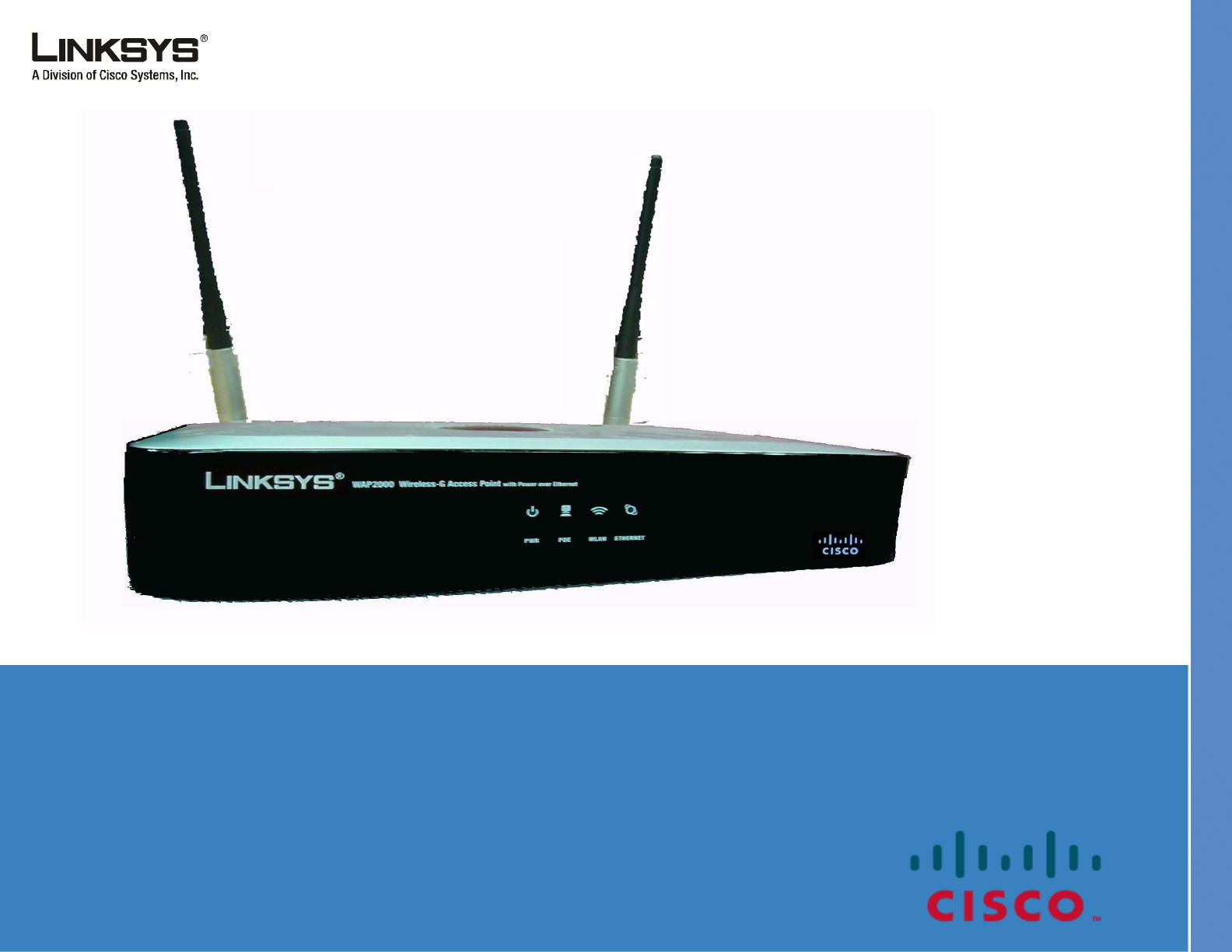
LINKSYS ONE READY COMMUNICATIONS SOLUTION
Linksys Business Series Wireless-G Access Point
Model WAP2000
With Power Over Ethernet User Guide
Release 2.0
© 2007 Copyright, Cisco Systems, Inc.
Specifications are subject to change without notice.
Linksys, the Cisco Systems logo, the Linksys Logo, and the Linksys One logo are registered trademarks of Cisco Systems, Inc. All other trademarks mentioned in this document are
the property of their respective owners.

i
Linksys One Ready Communications Solution
Contents
Chapter 1: Introduction - - - - - - - - - - - - - - - - - - - - - - - - - - -1
Welcome 1
What’s in this User Guide? 2
Chapter 2: Planning Your Wireless Network - - - - - - - - - - - - - - - -5
Network Topology 5
Roaming 5
Network Layout 6
Chapter 3: Connecting the Wireless-G Access Point - - - - - - - - - - - - -7
Overview 7
Connection 7
Placement Options 7
Wall-Mount Option 7
Chapter 4: Getting to Know the Wireless-G Access Point - - - - - - - - - -9
The LEDs 9
The Ports 10
Antennas and Positions 12
Antenna 12
Chapter 5: Setting Up the Wireless-G Access Point - - - - - - - - - - - - 13
Overview 13
Setup 13
Management 13
Wireless 13
Navigating the Utility 14
Setup 14
Wireless 15
AP Mode 15
Administration 15
Status 16

ii
Linksys One Ready Communications Solution
Chapter 6: Configuring the Wireless-G Access Point - - - - - - - - - - - 17
The Setup - Basic Setup Tab 17
Setup 17
IP Settings 18
The Setup - Time Tab 18
Time 18
The Wireless - Basic Wireless Settings Tab 19
Basic Settings 19
The Wireless - Wireless Security Tab 20
Wireless Security 20
The Wireless - Wireless Connection Control Tab 25
Wireless Connection Control 25
Wireless Client List 25
The Wireless - Advanced Wireless Settings Tab 26
Advanced Settings 26
The Wireless - VLAN & QoS Tab 27
The AP Mode Tab 28
The Administration - Management Tab 29
The Administration - Log Tab 31
The Administration - Factory Default Tab 32
The Administration - Firmware Upgrade Tab 33
The Administration - Reboot Tab 33
The Administration - Config Management Tab 33
The Status - Local Network Tab 34
The Status - Wireless Tab 35
The Status - System Performance Tab 35
Troubleshooting 37
Wireless Security 43
Upgrading Firmware 47
Windows Help 49
Glossary 51

iii
Linksys One Ready Communications Solution
Regulatory Information 58
Linksys Contact Information 60

iv
Linksys One Ready Communications Solution

1
Chapter 1: Introduction
Welcome
Linksys One Ready Communications Solution
Chapter
1Introduction
Welcome
Thank you for choosing the Wireless-G Access Point with Power Over Ethernet and
Rangebooster. This Access Point will allow you to network wirelessly better than ever.
How does the Access Point do all of this? An access point allows for greater range and mobility
within your wireless network while also allowing you to connect the wireless network to a wired
environment. In fact, the Wireless-G Access Point with Power Over Ethernet and Rangebooster
can support communications on up to four wireless networks, using Virtual Local Area Network
(VLAN) technology.
The Wireless-G Access Point with Power Over Ethernet and Rangebooster also offers the
convenience of Power over Ethernet (PoE) capability, so it can receive data and power over a
single Ethernet network cable. You can even connect wired networks in two different buildings,
by using two Access Points set to Wireless Bridge mode.
But what does all of this mean?
Networks are useful tools for sharing computer resources. You can access one printer from
different computers and access data located on another computer's hard drive. Networks are even
used for playing multiplayer video games. So, networks are not only useful in homes and offices,
they can also be fun.
PCs on a wired network create a LAN, or Local Area Network. They are connected with
Ethernet cables, which is why the network is called “wired”.
PCs equipped with wireless client cards or adapters can communicate without cumbersome
cables. By sharing the same wireless settings, within their transmission radius, they form a
wireless network. This is sometimes called a WLAN, or Wireless Local Area Network. The
Access Point bridges wireless networks of both 802.11g and 802.11b standards and wired
networks.
Use the instructions in this Guide to help you connect the Access Point, set it up, and configure it
to bridge your different networks. These instructions should be all you need to get the most out
of the Access Point.
access point: a device that allows wireless-equipped computers
and other devices to communicate with each other and with
devices on a wired network. Also used to expand the range of a
wireless network.
network: a series of computers or devices connected
together.
lan (local area network): the computers and networking devices
that make up your local network.
poe (power over ethernet): a technology enabling an Ethernet
network cable to deliver both data and power.
ethernet: network protocol defined in IEEE 802.3 standard
that specifies how data is placed on and retrieved from a
common transmission medium.
adapter: a device that adds network functionality to your PC.
802.11g: a wireless networking standard that specifies a
maximum data transfer rate of 54Mbps, an operating frequency
of 2.4GHz, and backward compatibility with 802.11b devices.
802.11b: a wireless networking standard that specifies a
maximum data transfer rate of 11Mbps and an operating
frequency of 2.4GHz.

Chapter
1
2Chapter 1: Introduction
What’s in this User Guide?
Linksys One Ready Communications Solution
What’s in this User Guide?
This user guide covers the steps for setting up and using the Wireless-G Access Point.
• Chapter 1: Introduction
This chapter describes the Wireless-G Access Point’s applications and this User Guide.
• Chapter 2: Planning your Wireless Network
This chapter describes the basics of wireless networking.
• Chapter 3: Getting to Know the Wireless-G Access Point
This chapter describes the physical features of the Access Point.
• Chapter 4: Connecting the Wireless-G Access Point
This chapter instructs you on how to connect your Access Point to your network and
placement options.
• Chapter 5: Setting up the Wireless-G Access Point
This chapter explains how to perform the most basic setting changes through the Web-based
Utility.
• Chapter 6: Configuring the Wireless-G Access Point
This chapter provides a reference for the available configuration through the Web-based
Utility.
• Appendix A: Troubleshooting
This appendix describes some frequently asked questions regarding installation and use of
the Wireless-G Access Point with Power Over Ethernet and Rangebooster.
• Appendix B: Wireless Security
This appendix explains the risks of wireless networking and some solutions to reduce the
risks.
• Appendix C: Upgrading Firmware
This appendix instructs you on how to upgrade the Access Point’s firmware.
• Appendix D: Windows Help.
This appendix describes some of the ways Windows can help you with wireless networking.
• Appendix E: Glossary
This appendix gives a brief glossary of terms frequently used in networking.

3
Chapter 1: Introduction
What’s in this User Guide?
Linksys One Ready Communications Solution
Chapter
1• Appendix F: Regulatory Information
This appendix supplies the Access Point’s regulatory information.
• AppendixG: Contact Information
This appendix provides contact information for a variety of Linksys resources, including
Technical Support.

Chapter
1
4Chapter 1: Introduction
What’s in this User Guide?
Linksys One Ready Communications Solution

5
Chapter 2: Planning Your Wireless Network
Network Topology
Linksys One Ready Communications Solution
Chapter
2Planning Your Wireless Network
Network Topology
A wireless network is a group of computers, each equipped with one or more wireless adapters.
Computers in a wireless network must be configured to share the same radio channel to talk to
each other. Several PCs equipped with wireless cards or adapters can communicate with each
other to form an ad-hoc network without the use of an access point.
Linksys also provides products to allow wireless adaptors to access wired network through a
bridge such as the wireless access point, or wireless router. An integrated wireless and wired
network is called an infrastructure network. Each wireless PC in an infrastructure network can
talk to any computer in a wired or wireless network via the access point or wireless router.
An infrastructure configuration extends the accessibility of a wireless PC to a wired network,
and may double the effective wireless transmission range for two wireless adapter PCs. Since an
Access Point is able to forward data within a network, the effective transmission range in an
infrastructure network may be more than doubled since Access Point can transmit signal at
higher power to the wireless space.
Roaming
Infrastructure mode also supports roaming capabilities for mobile users. Roaming means that
you can move your wireless PC within your network and the access points will pick up the
wireless PC's signal, providing that they both share the same wireless network (SSID), wireless
channel, and wireless security settings.
This Access Point has 802.11F Inter-Access Point Protocol (IAPP) to complete the roaming
process in seconds. If your wireless networks share the same IP subnet, this will not disrupt your
data connection while moving around.
Before you consider roaming, choose a feasible radio channel and optimum access point
position. Proper access point positioning combined with a clear radio signal will greatly enhance
performance.
ad-hoc: a group of wireless devices communicating
directly with each other (peer-to-peer) without the use of
an access point.
infrastructure: a wireless network that is bridged to a
wired network via an access point.
hardware: the physical aspect of
computers, telecommunications, and
other information technology devices.
roaming: the ability to take a wireless device from one
access point's range to another without losing the
connection.
ssid: your wireless network's name

Chapter
2
6Chapter 2: Planning Your Wireless Network
Network Layout
Linksys One Ready Communications Solution
Network Layout
The Wireless-G Access Point with Power Over Ethernet and Rangebooster has been designed
for use with 802.11g and 802.11b products. The Access Point is compatible with 802.11g and
802.11b adapters, such as the notebook adapters for your laptop computers, PCI adapters for
your desktop PCs, and USB adapters for all PCs when you want to enjoy wireless connectivity.
These wireless products can also communicate with an 802.11g or 802.11b wireless print server
(if available).
To link your wired network with your wireless network, connect the Access Point’s Ethernet
network port to any switch or router with Power over Ethernet (PoE)—or a PoE injector, such as
the Linksys WAPPOE or WAPPOE12. Note that the 12 VDC on the WAPPOE12 is for the
splitter output. Both PoE Injectors provide 48 VDC power output.

7
Chapter 3: Connecting the Wireless-G Access Point
Overview
Linksys One Ready Communications Solution
Chapter
3Connecting the Wireless-G Access Point
Overview
This chapter explains how to place and connect the Access Point.
Depending on your application, you might want to set up the device first before mounting the
device. Refer to “Chapter 5: Setting Up the Wireless-G Access Point”.
Connection
1. Connect your Ethernet network cable to your network router or switch. Then connect the
other end of the network cable to the Access Point’s Ethernet port.
2. If you are using Power Over Ethernet (POE), proceed to the following section, “Placement
Options.”
3. If you are not using POE, then connect the included power adapter to the Access Point’s
Power port. Then plug the power adapter into an electrical outlet. The LEDs on the front
panel will light up as soon as the Access Point powers on.
Proceed to the following section, “Placement Options.”
Placement Options
There are two ways to place the Wireless-G Access Point. The first way is to place it horizontally
on a surface, so it sits on its four rubber feet.The second way is to mount it on a wall. The wall-
mount options are explained in further detail below.
Now that the hardware installation is complete, proceed to “Chapter 5: Setting up the Wireless-G
Access Point,” for directions on how to set up the Access Point.
Wall-Mount Option
1. On the Access Point’s back panel are two crisscross wall-mount slots.
2. Determine where you want to mount the Access Point, and install two screws that are 2-15/
16" apart.
Connect the Ethernet Cable
Connect the Power

Chapter
3
8Chapter 3: Connecting the Wireless-G Access Point
Wall-Mount Option
Linksys One Ready Communications Solution
3. Line up the Access Point so that the wall-mount slots line up with the two screws.
4. Place the wall-mount slots over the screws and slide the Access Point down until the screws
fit snugly into the wall-mount slots.
5. Now that the hardware installation is complete, proceed to “Chapter 5: Setting up the
Wireless-G Access Point,” for directions on how to set up the Access Point.
2-15/16"
Mounting Dimensions

9
Chapter 4: Getting to Know the Wireless-G Access Point
The LEDs
Linksys One Ready Communications Solution
Chapter
4Getting to Know the Wireless-G Access Point
The LEDs
The Access Point's LEDs, where information about network activity is displayed, are located on
the front panel.
Power Green. The Power LED lights up when the Access Point is
powered on.
PoE Green. The PoE LED lights up when the Access Point is
powered through Ethernet cable.
WLAN
Green. The WIRELESS LED lights up when the wireless
module is active on the Access Point. If the Wireless LED is
flashing, the Access Point is actively sending to or receiving
data from a wireless device.
ETHERNET
Green. The ETHERNET LED lights up when the Access Point
is successfully connected to a device through the Ethernet
network port. If the ETHERNET LED is flashing, the Access
Point is actively sending to or receiving data from one of the
devices over the Ethernet network port.
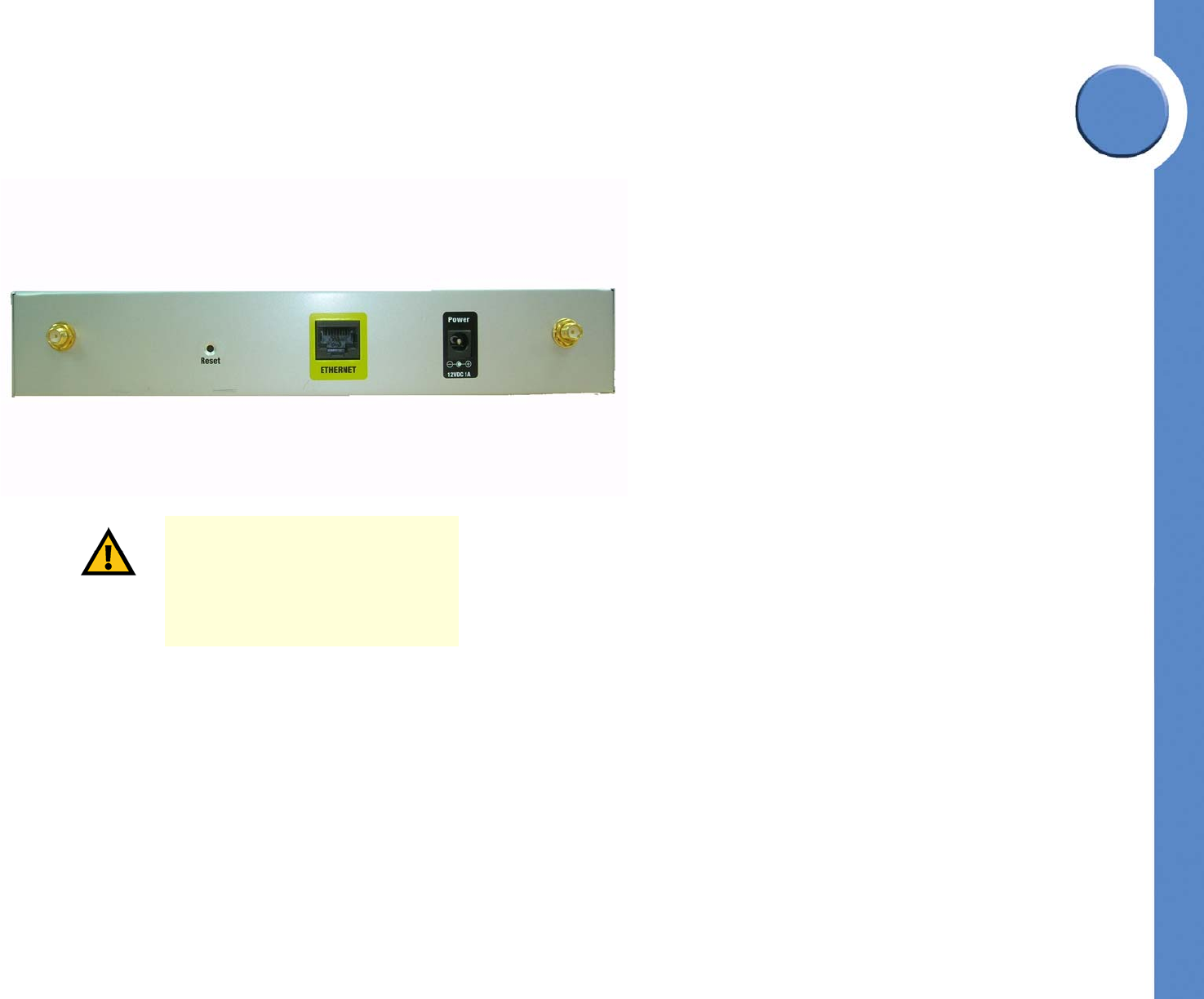
Chapter
4
10 Chapter 4: Getting to Know the Wireless-G Access Point
The Ports
Linksys One Ready Communications Solution
The Ports
The Access Point’s port are located on the back of the device. port: the connection point on a computer
or networking device used for plugging in
cables or adapters
IMPORTANT: Resetting the Access
Point will erase all of your settings
(including wireless security, IP address,
and SSID) and replace them with the
factory defaults. Do not reset the Access
Point if you want to retain these settings.

11
Chapter 4: Getting to Know the Wireless-G Access Point
The Ports
Linksys One Ready Communications Solution
Chapter
4
Reset Button
There are two ways to reset the Access Point to the factory
default configuration. Either press the Reset button, for
approximately ten seconds, or restore the defaults using the
Access Point's Web-based Utility. Note: If you press the reset
button for less than 10 seconds, the device will simply reboot
without reseting to the factory default.
Ethernet The Ethernet network port connects to Ethernet network
devices, such as a switch or router that may or may not support
Power over Ethernet (PoE).
Power The Power port connects to the supplied power adapter.
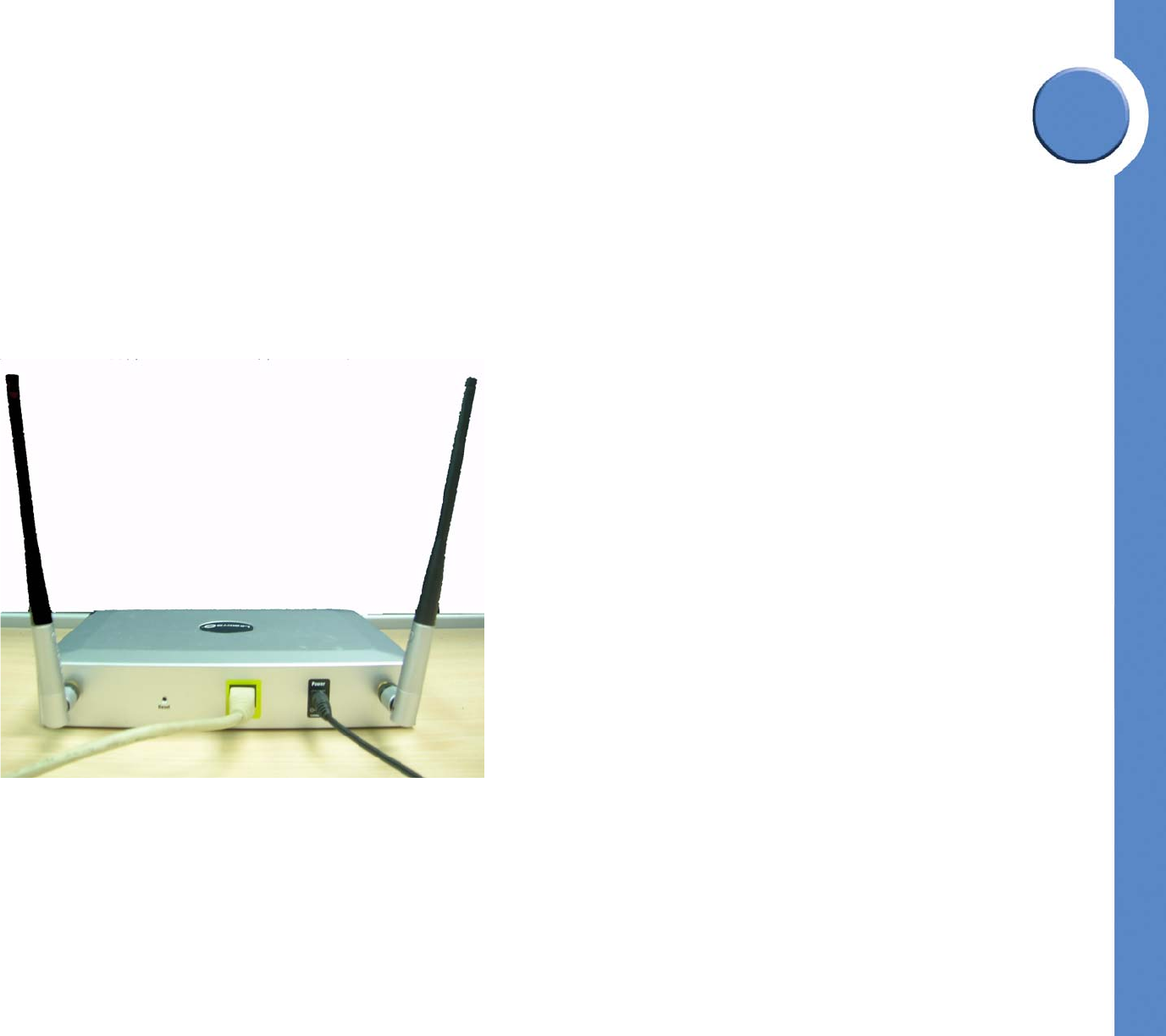
Chapter
4
12 Chapter 4: Getting to Know the Wireless-G Access Point
Antennas and Positions
Linksys One Ready Communications Solution
Antennas and Positions
The Access Point’s antennas are located on the back of the device. The Access Point can be
placed on a desktop or wall-mounted. When placed on a desktop, the Access Point can be
stacked with other Linksys Business Series products.
Antenna
The Access Point has two detachable 2dBi omni-directional antennas. Adjust the two antennas
so that they form a 90 degree angle for best MIMO range performance.

13
Chapter 5: Setting Up the Wireless-G Access Point
Overview
Linksys One Ready Communications Solution
Chapter
5Setting Up the Wireless-G Access Point
Overview
The Access Point has been designed to be functional right out of the box with the default
settings. However, if you'd like to change these settings, the Access Point can be configured
through your web browser with the web-based Utility. This chapter explains how to use the
Utility to perform the most basic settings.
The Utility can be accessed via web browsers, such as Microsoft Internet Explorer or Mozilla
Firefox through the use of a computer that is networked with the Access Point.
For a basic network setup, most users only have to use the following screens of the Utility:
Setup
On the Setup screen, enter your basic network settings (IP address) here.
Management
Click the Administration tab and then select the Management screen. The Access Point’s
default password is admin. To secure the Access Point, change the AP Password from its
default.
Most users will also customize their wireless settings:
Wireless
On the Wireless screen, change default SSID under the Basic Wireless Settings Tab. Select the
level of security under the Wireless Security Tab and complete the options for the selected
security mode.
IMPORTANT: Have you enabled TCP/
IP on your PCs? PCs communicate over
the network with this protocol. Refer to
“Appendix D: Windows Help” for more
information on TCP/IP
tcp/ip: a set of protocols PCs use to
communicate over a network.
browser: an application that provides a way to
look at and interact with all the information on
the World Wide Web.

Chapter
5
14 Chapter 5: Setting Up the Wireless-G Access Point
Navigating the Utility
Linksys One Ready Communications Solution
There are three ways to connect to your Access Point for the first time.
1. If you have a 48VDC Power Injector (e.g. Linksys WAPPOE), power up your Access Point
first, then connect the Injector’s cable to your PC. Configure your PC to have the static IP
address on the same subnet as the Access Point’s default IP address (192.168.1.245).
2. If you have a PoE switch (e.g. Linksys SRW224P), connect your Access Point and your PC
to the same network. Configure your PC to have the static IP address on the same subnet as
the Access Point’s default IP address (192.168.1.245). Or if there is a DHCP server
connected to the switch, configure it to assign the IP address in 192.168.1.0/24 subnet. Your
PC will get an IP address in the subnet through the DHCP.
3. Although it is not recommended, you can connect your PC wirelessly to the Access Point
when the DHCP server is connected on the LAN side. It is not recommended, because you
can easily lose your connection through configuration changes.
Launch your web browser, such as Internet Explorer or Mozilla Firefox and enter the Access
Point’s default IP address, 192.168.1.245, in the Address field. Press the Enter key.
Enter admin in the User Name field. The first time you open the Web-based Utility, use the
default password, admin. (You can set a new password from the Administration - Management
tab.) Then click the OK button.
After setting up the Access Point to use DHCP or manually configure a new IP address, move
your Access Point to the desired network. You will have to use the new IP address the next time
you access the Web-based Utility.
Navigating the Utility
The Web-based Utility consists of the following five main tabs: Setup, Wireless, Security
Monitor, Administration, and Status. Additional screens (sub tabs) will be available from most
of the main tabs.
The following briefly describes the main & sub tabs of the Utility.
Setup
Enter the Host Name, IP Address settings, and set the time on this screen.
•Basic Setup. Configure the host name and IP address settings for this Access Point.
Login Screen

15
Chapter 5: Setting Up the Wireless-G Access Point
Navigating the Utility
Linksys One Ready Communications Solution
Chapter
5• Time -Set the time on this Access Point.
Wireless
You will use the Wireless tabs to enter a variety of wireless settings for the Access Point.
•Basic Wireless Settings. Choose the wireless network mode (e.g. Mixed), SSID, and radio
channel on this screen.
•Wireless Security. Use this screen to configure the Access Point’s security settings.
•Wireless Connection Control. Use this screen to control the wireless connections from client
devices to this Access Point.
•Advanced Wireless Settings. Use this screen to configure the Access Point’s more advanced
wireless settings.
•VLAN & QoS. Use this screen to configure VLAN and QoS settings.
AP Mode
Use this screen to configure the Access Point mode. The three available modes are Access Point,
Wireless Repeater, and Wireless Bridge.
Administration
You will use the Administration tabs to manage the Access Point.
•Management. This screen allows you to customize the password and Simple Network
Management Protocol (SNMP) settings.
•Log. Configure the Log settings for the Access Point on this screen.
•Factory Default. Use this screen to reset the Access Point to its factory default settings.
•Firmware Upgrade. Upgrade the Access Point’s firmware on this screen.
•Reboot. Use this screen to reboot the Access Point.
•Config Management. You can save the configuration file for the Access Point to your PC, as
well as restore the backup configuration file to the Access Point.
snmp: the standard network management
protocol on the Internet.
firmware: the software image that runs on a
CPU inside a networking device.

Chapter
5
16 Chapter 5: Setting Up the Wireless-G Access Point
Navigating the Utility
Linksys One Ready Communications Solution
Status
You will be able to view status information for your local network, wireless networks, and
network performance.
•Local Network. This screen displays system information, including software & hardware
version, MAC address, and IP address on the LAN side of the Access Point.
•Wireless. This screen displays wireless network settings including SSID, network mode, and
wireless channel.
•System Performance. This screen displays the current traffic statistics of this Access Point
for both Wireless and LAN ports.

17
Chapter 6: Configuring the Wireless-G Access Point
The Setup - Basic Setup Tab
Linksys One Ready Communications Solution
Chapter
6Configuring the Wireless-G Access Point
This chapter is a detailed reference guide for the Web-based Utility. You do not need the Utility
to start using your Access Point. The Access Point has been designed to be functional right out
of the box with the default settings. You also have the option to follow the instructions in
“Setting Up the Wireless-G Access Point” on page 12 to perform the most basic settings without
reading through this chapter.
The Setup - Basic Setup Tab
The first screen that appears is the Setup screen. This allows you to change the Access Point's
general settings.
Setup
Enter names for the Access Point. The host name can be used to access the Web Utility through
the network if DNS has been set up. The device name is for the benefit of identifying your
Access Point after you log in.
Host Name. This is the host name assigned to the Access Point. This host name will be
published to your DNS server if the Access Point is configured to acquire the IP address through
DHCP. In that case, Linksys recommends to follow the company policy on the host name
assignment. The default name is Linksys.
Device Name. You may assign any device name to the Access Point. This name is only used by
the Access Point administrator for identification purposes. Unique, memorable names are
helpful, especially if you are employing multiple access points on the same network. The default
name is WAP2000.
Contact. This field is used for entering the contact information. You may enter the name for the
Access Point’s owner or the person who administers this device.
Location. This field is used for entering the device’s location. You may enter the location, i.e.
room or floor number of the building where the device locates.
Network Setup
The selections under this heading allow you to configure the Access Point’s IP address
setting(s).

Chapter
6
18 Chapter 6: Configuring the Wireless-G Access Point
The Setup - Time Tab
Linksys One Ready Communications Solution
IP Settings
Select Static IP Address (default) if you want to assign a static or fixed IP address to the Access
Point and then complete the following:
•Local IP Address. The IP address must be unique to your network. The default IP address is
192.168.1.245.
•Subnet Mask. The Subnet Mask must be the same as that set on the LAN that your Access
Point is connected to. The default is 255.255.255.0.
•Default Gateway. Your ISP will provide you with the Default Gateway Address, which is
the ISP server’s IP address.
•Primary DNS (Required) and Secondary DNS (Optional). Your ISP will provide you
with at least one DNS (Domain Name System) Server IP Address.
Select Automatic Configuration - DHCP if you have a DHCP server enabled on the LAN that
can assign an IP address to the Access Point.
Change these settings as described here and click Apply to apply your changes, or cancel your
changes by not applying your changes. Help information is available on the upper-right-hand
side of the screen.
The Setup - Time Tab
This allows you to change the Access Point's time settings. The correct time setting can help the
administrator to search the system log to identify problems.
Time
You can set the time either manually or automatically from a time server if the Access Point can
access the public Internet.
Manually. Select this option to set the date and time manually. The default is to set the time
manually.
NTP. Select this option and time zone. The Access Point will contact the public time server to
get the current time.
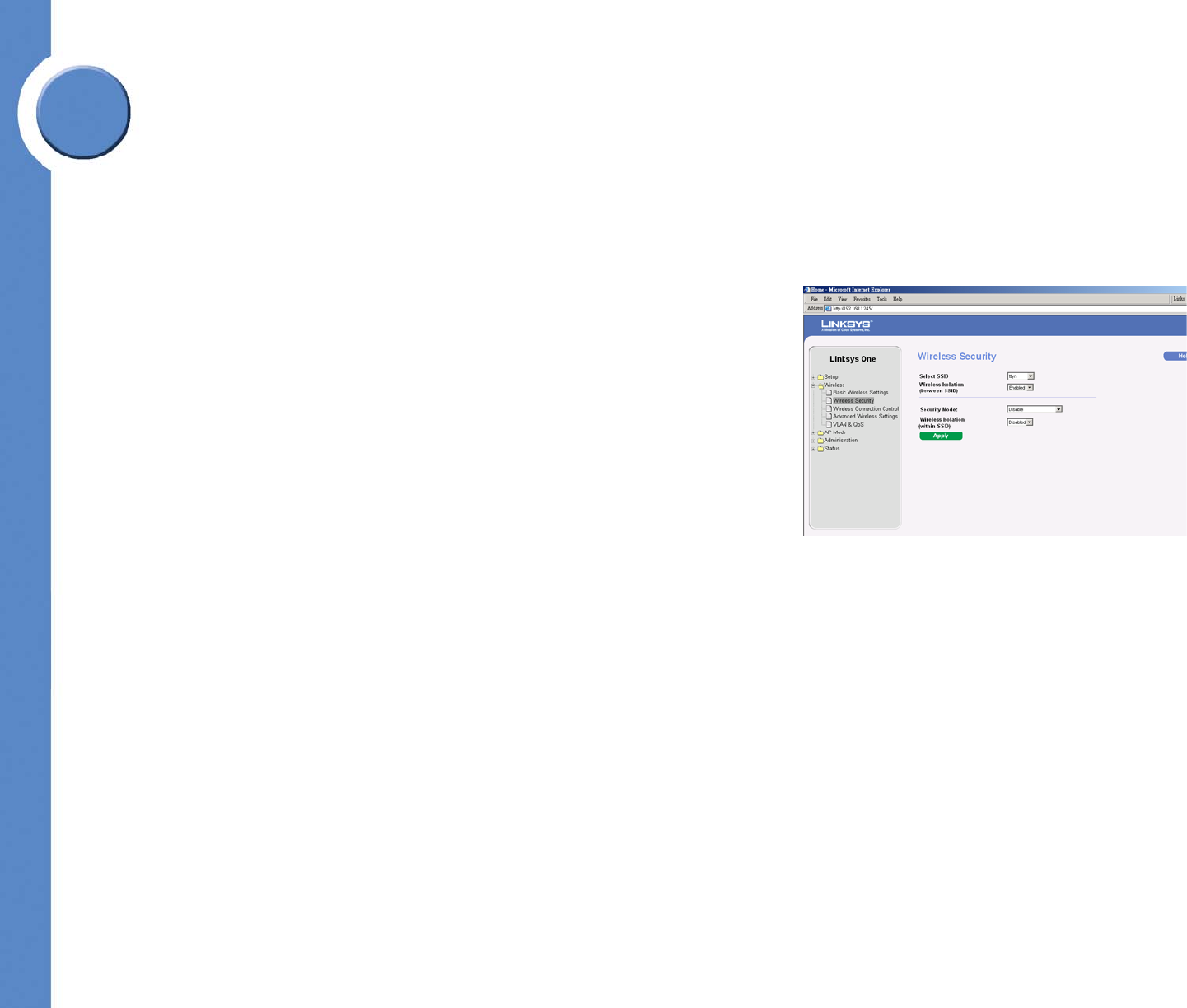
19
Chapter 6: Configuring the Wireless-G Access Point
The Wireless - Basic Wireless Settings Tab
Linksys One Ready Communications Solution
Chapter
6Automatically adjust clock for daylight saving changes. Select this option if you are in using
the Access Point in a location that observes daylight saving time.
User Defined NTP Server. Enable this option if you have set up local NTP server. Default is
Disabled.
NTP Server IP. Enter the IP address of user defined NTP Server.
Change these settings as described here and click Apply to apply your changes, or cancel your
changes by not applying your changes. Help information is available on the upper-right-hand
side of the screen.
The Wireless - Basic Wireless Settings Tab
Change the basic wireless network settings on this screen. The Access Point can connect to up to
four wireless networks (SSIDs) at the same time, so this screen offers settings for up to four
different SSIDs. Each SSID owns its own MAC address on this Access Point.
Basic Settings
Configure the Wireless Network basic attributes for the entire system and for each SSID.
Wireless Network Mode. Select one of the following modes. The default is Mixed.
Disable: To disable wireless connectivity completely. This might be useful during system
maintenance.
B-Only: All the wireless client devices can be connected to the Access Point at Wireless-B data
rates with maximum speed at 11Mbps.
G-Only: Wireless-G client devices can be connected at Wireless-G data rates with maximum
speed at 54Mbps. Wireless-B clients cannot be connected in this mode.
Mixed: Both Wireless-B and Wireless-G client devices can be connected at their respective data
rates. Wireless-G devices can be connected at Wireless-G data rates.
Wireless Channel. Select the appropriate channel to be used among your Access Point and your
client devices. The default is channel 6. You can also select Auto so that your Access Point will
select the channel with the lowest amount of wireless interference while the system is powering
up. Auto channel selection will start when you click Save Settings button, it will take several
seconds to scan through all the channels to find the best channel.

Chapter
6
20 Chapter 6: Configuring the Wireless-G Access Point
The Wireless - Wireless Security Tab
Linksys One Ready Communications Solution
SSID Name. The SSID is the unique name shared among all devices in a wireless network. It is
case-sensitive, must not exceed 32 alphanumeric characters, and may be any keyboard character.
Make sure this setting is the same for all devices in your wireless network. The default SSID
name is linksys-g.
SSID Broadcast. This option allows the SSID to be broadcast on your network. You may want
to enable this function while configuring your network, but make sure that you disable it when
you are finished. With this enabled, someone could easily obtain the SSID information with site
survey software or Windows XP and gain unauthorized access to your network. Click Enabled
to broadcast the SSID to all wireless devices in range. Click Disabled to increase network
security and prevent the SSID from being seen on networked PCs. The default is Enabled in
order to help users configure their network before use.
Change these settings as described here and click Apply to apply your changes, or cancel your
changes by not applying them. Help information is available on the right side of the screen.
The Wireless - Wireless Security Tab
Change the Access Point’s wireless security settings on this screen.
Wireless Security
Select SSID. Select any of the SSID names configured on the Basic Wireless Settings tab.
Wireless Isolation (between SSID). Wireless Isolation prevents eavesdropping in the network.
When it is Enabled, wireless frames received on this Access Point will not be forwarded to other
wireless networks (SSIDs). For example, if you have a wireless hotspot, you may want to keep
the wireless network (SSID) isolated from your other wireless networks (SSIDs). This is a global
option applying to all SSIDs. The default is Enabled.
The following options are specific for each SSID:
Security Mode. Select the wireless security mode you want to use, WEP, WPA-Personal,
WPA2-Personal, WPA2-Personal Mixed, WPA-Enterprise, WPA2-Enterprise, WPA2-
Mixed, or RADIUS. (WPA stands for Wi-Fi Protected Access, which is a security standard
stronger than WEP encryption and forward compatible with IEEE 802.11i. WEP stands for
Wired Equivalent Privacy, Enterprise modes use a RADIUS server for authentication, while
RADIUS stands for Remote Authentication Dial-In User Service.) Refer to the appropriate
instructions below after you select the Authentication Type and SSID Interoperability settings.
For detailed instructions on configuring wireless security for the Access Point, refer to
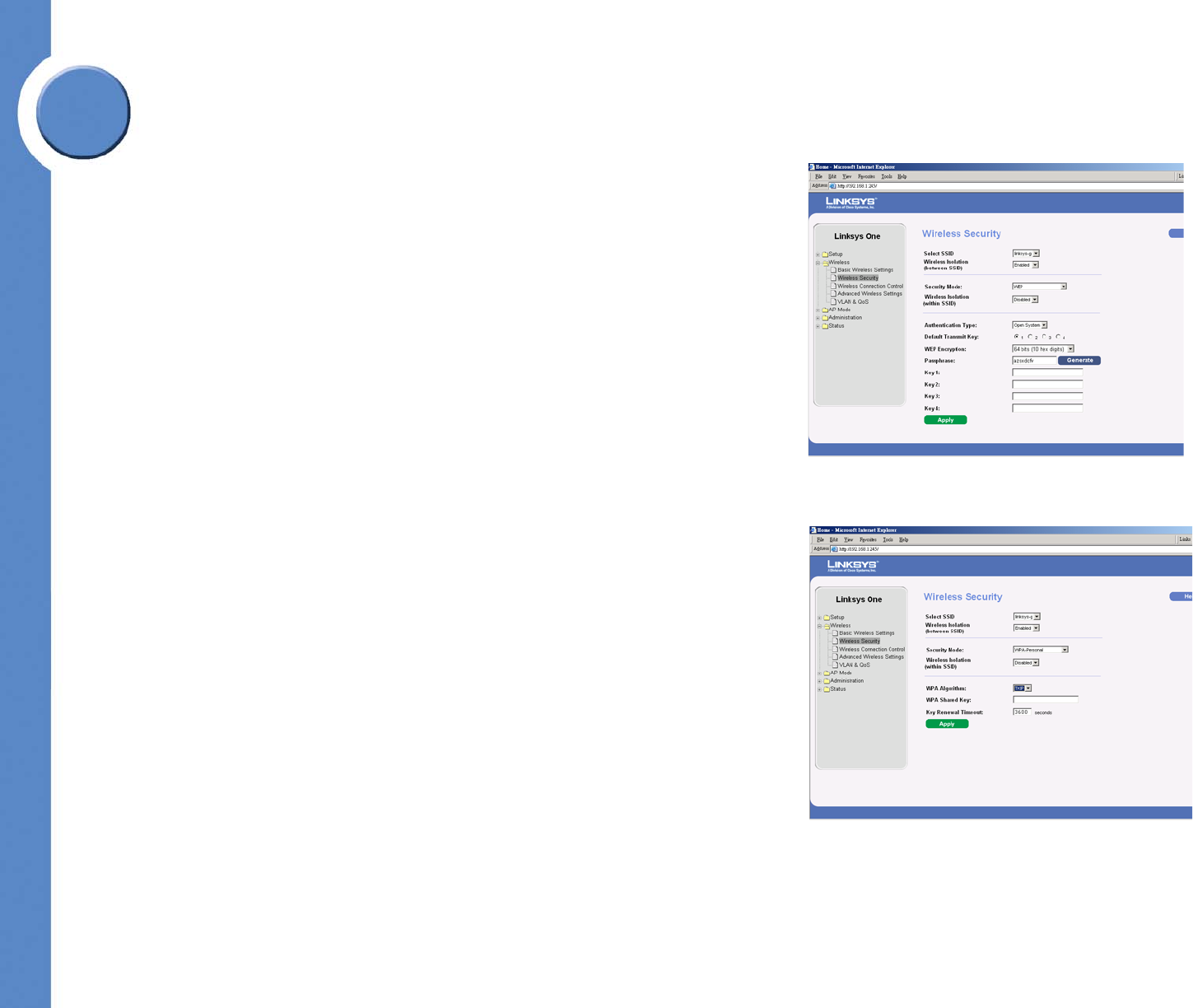
21
Chapter 6: Configuring the Wireless-G Access Point
The Wireless - Wireless Security Tab
Linksys One Ready Communications Solution
Chapter
6“Appendix B: Wireless Security.” To disable wireless security completely, select Disabled. The
default is Disabled.
Wireless Isolation (within SSID). When disabled, wireless PCs that are associated to the same
network name (SSID) can see and transfer files between each other. By enabling this feature,
Wireless PCs will not be able to see each other. This feature is very useful when setting up a
wireless hotspot location. The default is Disabled.
Following section describes the detailed options for each Security Mode.
WEP
This security mode is defined in the original IEEE 802.11. This mode is not recommended now
due to its weak security protection. Users are urged to migrate to WPA or WPA2.
Authentication Type. Choose the 802.11 authentication type as either Open System or Shared
Key. The default is Open System.
Default Transmit Key. Select the key to be used for data encryption.
WEP Encryption. Select a level of WEP encryption, 64 bits (10 hex digits) or 128 bits (26 hex
digits).
Passphrase. If you want to generate WEP keys using a Passphrase, then enter the Passphrase in
the field provided and click the Generate key. Those auto-generated keys are not as strong as
manual WEP keys.
Key 1-4. If you want to manually enter WEP keys, then complete the fields provided. Each WEP
key can consist of the letters “A” through “F” and the numbers “0” through “9”. It should be 10
characters in length for 64-bit encryption or 26 characters in length for 128-bit encryption.
Change these settings as described here and click Save Settings to apply your changes, or click
Cancel Changes to cancel your changes. Help information is available on the right side of the
screen.
WPA-Personal (aka WPA-PSK)
WPA Algorithm. WPA offers you two encryption methods, TKIP and AES for data encryption.
Select the type of algorithm you want to use, TKIP or AES. The default is TKIP.
WPA Shared Key. Enter a WPA Shared Key of 8-63 characters.
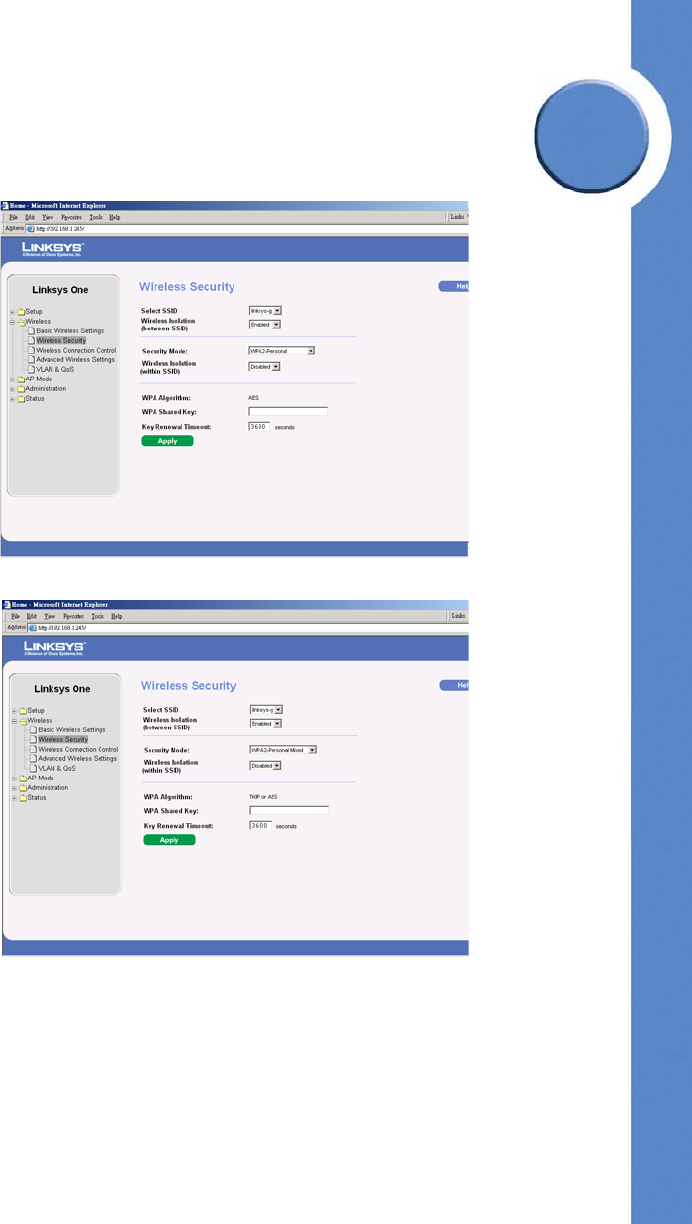
Chapter
6
22 Chapter 6: Configuring the Wireless-G Access Point
The Wireless - Wireless Security Tab
Linksys One Ready Communications Solution
Key Renewal Timeout. Enter a Key Renewal Timeout period, which instructs the Access Point
how often it should change the encryption keys. The default is 3600 seconds.
WPA2-Personal
WPA Algorithm. WPA2 always uses AvES for data encryption.
WPA Shared Key. Enter a WPA Shared Key of 8-63 characters.
Key Renewal Timeout. Enter a Key Renewal Timeout period, which instructs the Access Point
how often it should change the encryption keys. The default is 3600 seconds.
WPA2-Personal Mixed
This security mode supports the transition from WPA-Personal to WPA2-Personal. You can have
client devices that use either WPA-Personal or WPA2-Personal. The Access Point will
automatically choose the encryption algorithm used by each client device.
WPA Algorithm. Mixed Mode automatically chooses TKIP or AES for data encryption.
WPA Shared Key. Enter a WPA Shared Key of 8-63 characters.
Key Renewal Timeout. Enter a Key Renewal Timeout period, which instructs the Access Point
how often it should change the encryption keys. The default is 3600 seconds.
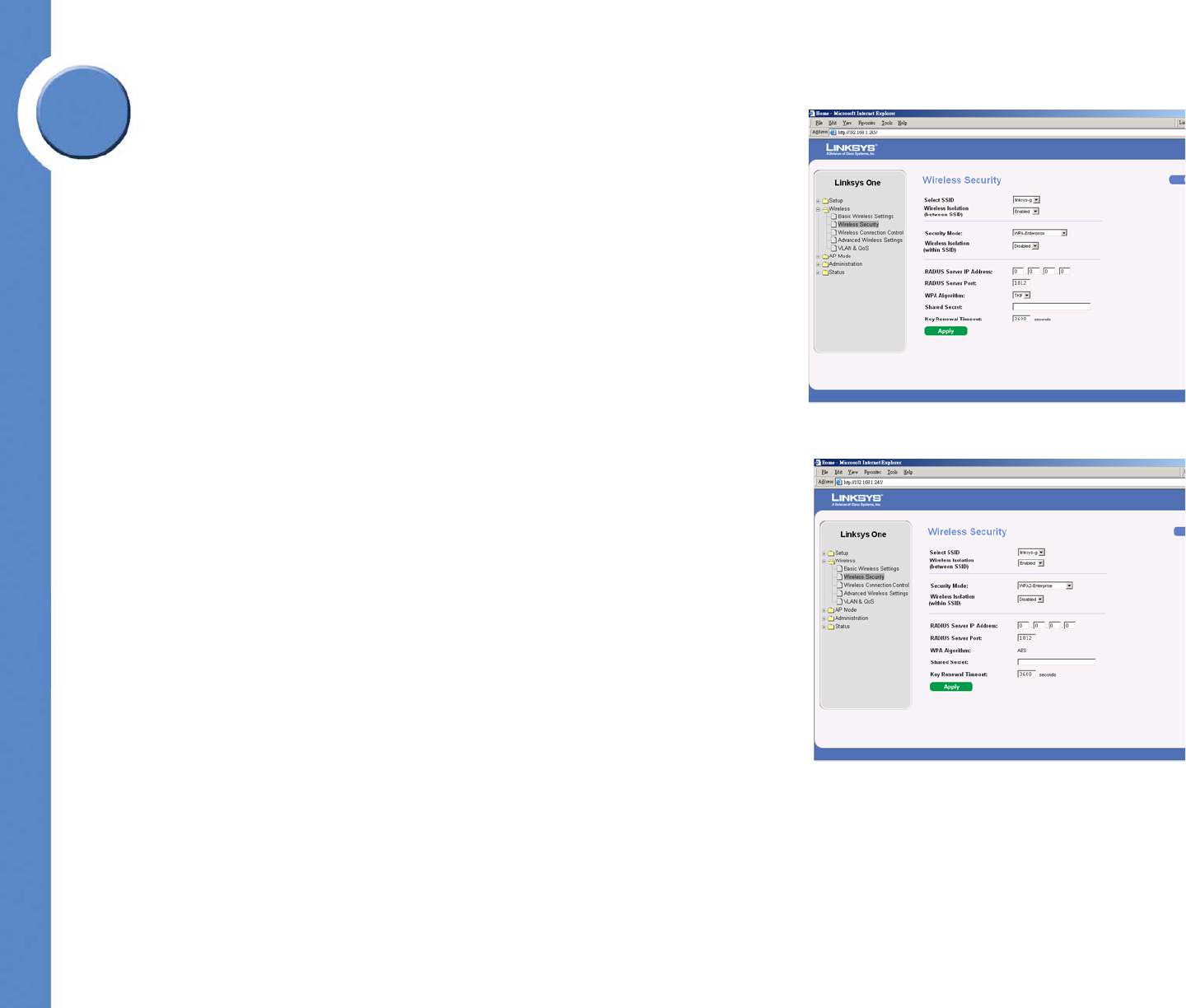
23
Chapter 6: Configuring the Wireless-G Access Point
The Wireless - Wireless Security Tab
Linksys One Ready Communications Solution
Chapter
6WPA-Enterprise
This option features WPA used in coordination with a RADIUS server for client authentication.
(This should only be used when a RADIUS server is connected to the Access Point.)
RADIUS Server IP Address. Enter the RADIUS server’s IP address.
RADIUS Server Port. Enter the port number used by the RADIUS server. The default is 1812.
WPA Algorithm. WPA offers you two encryption methods, TKIP and AES for data encryption.
Select the type of algorithm you want to use, TKIP or AES. The default is TKIP.
Shared Secret. Enter the Shared Secret key used by the Access Point and RADIUS server.
Key Renewal Timeout. Enter a Key Renewal Timeout period, which instructs the Access Point
how often it should change the encryption keys. The default is 3600 seconds.
WPA2-Enterprise
This option features WPA2 used in coordination with a RADIUS server for client authentication.
(This should only be used when a RADIUS server is connected to the Access Point.)
RADIUS Server IP Address. Enter the RADIUS server’s IP address.
RADIUS Server Port. Enter the port number used by the RADIUS server. The default is 1812.
WPA Algorithm. WPA2 always uses AES for data encryption.
Shared Secret. Enter the Shared Secret key used by the Access Point and RADIUS server.
Key Renewal Timeout. Enter a Key Renewal Timeout period, which instructs the Access Point
how often it should change the encryption keys. The default is 3600 seconds.
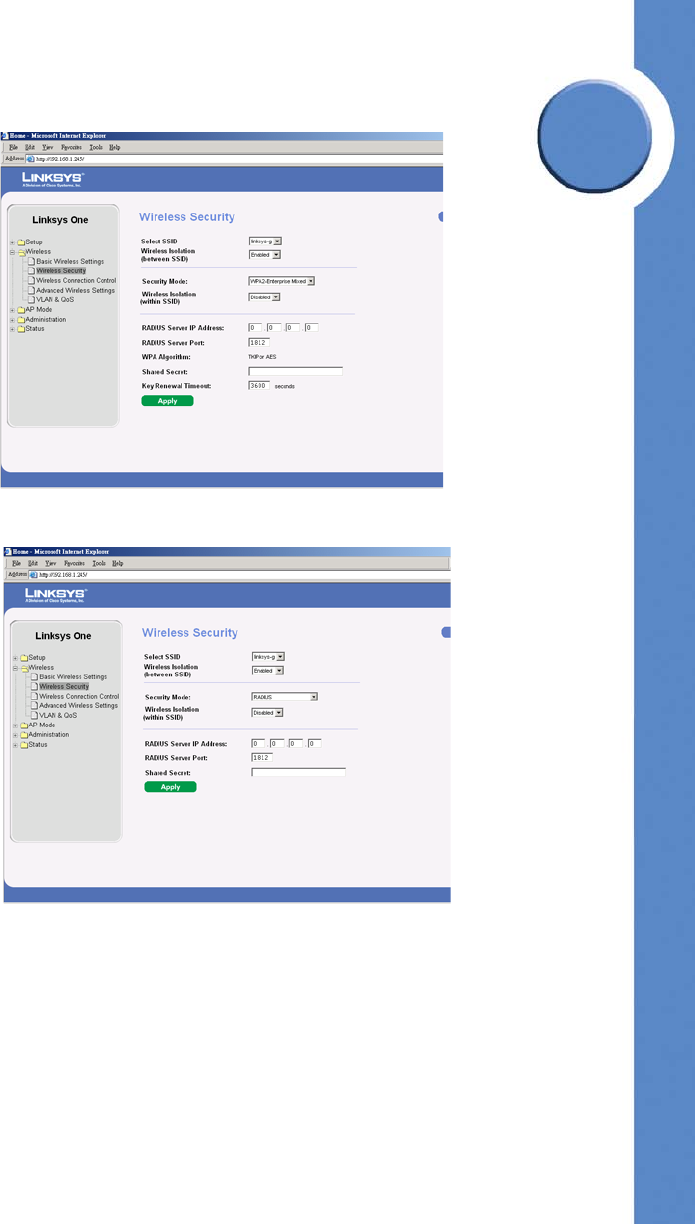
Chapter
6
24 Chapter 6: Configuring the Wireless-G Access Point
The Wireless - Wireless Security Tab
Linksys One Ready Communications Solution
WPA2-Enterprise Mixed
This security mode supports the transition from WPA-Enterprise to WPA2-Enterprise. You can
have client devices that use either WPA-Enterprise or WPA2-Enterprise. The Access Point will
automatically choose the encryption algorithm used by each client device.
RADIUS Server IP Address. Enter the RADIUS server’s IP address.
RADIUS Server Port. Enter the port number used by the RADIUS server. The default is 1812.
WPA Algorithm. Mixed Mode automatically chooses TKIP or AES for data encryption.
Shared Secret. Enter the Shared Secret key used by the Access Point and RADIUS server.
Key Renewal Timeout. Enter a Key Renewal Timeout period, which instructs the Access Point
how often it should change the encryption keys. The default is 3600 seconds.
RADIUS
This security mode is also known as Dynamic WEP with IEEE 802.1X. A RADIUS server is
used for client authentication and WEP is used for data encryption. The WEP key is
automatically generated by the RADIUS server. Manual WEP key is no longer supported to
ensure compatibility with Microsoft’s Windows implementation.
RADIUS Server IP Address. Enter the RADIUS server’s IP address.
RADIUS Server Port. Enter the port number used by the RADIUS server. The default is 1812.
Shared Secret. Enter the Shared Secret key used by the Access Point and RADIUS server.
Disable
There is no option to be configured for this mode.
When you have finished making changes to the screen, click the Save Settings button to save the
changes, or click the Cancel Changes button to undo your changes. Help information is
available on the right side of the screen.
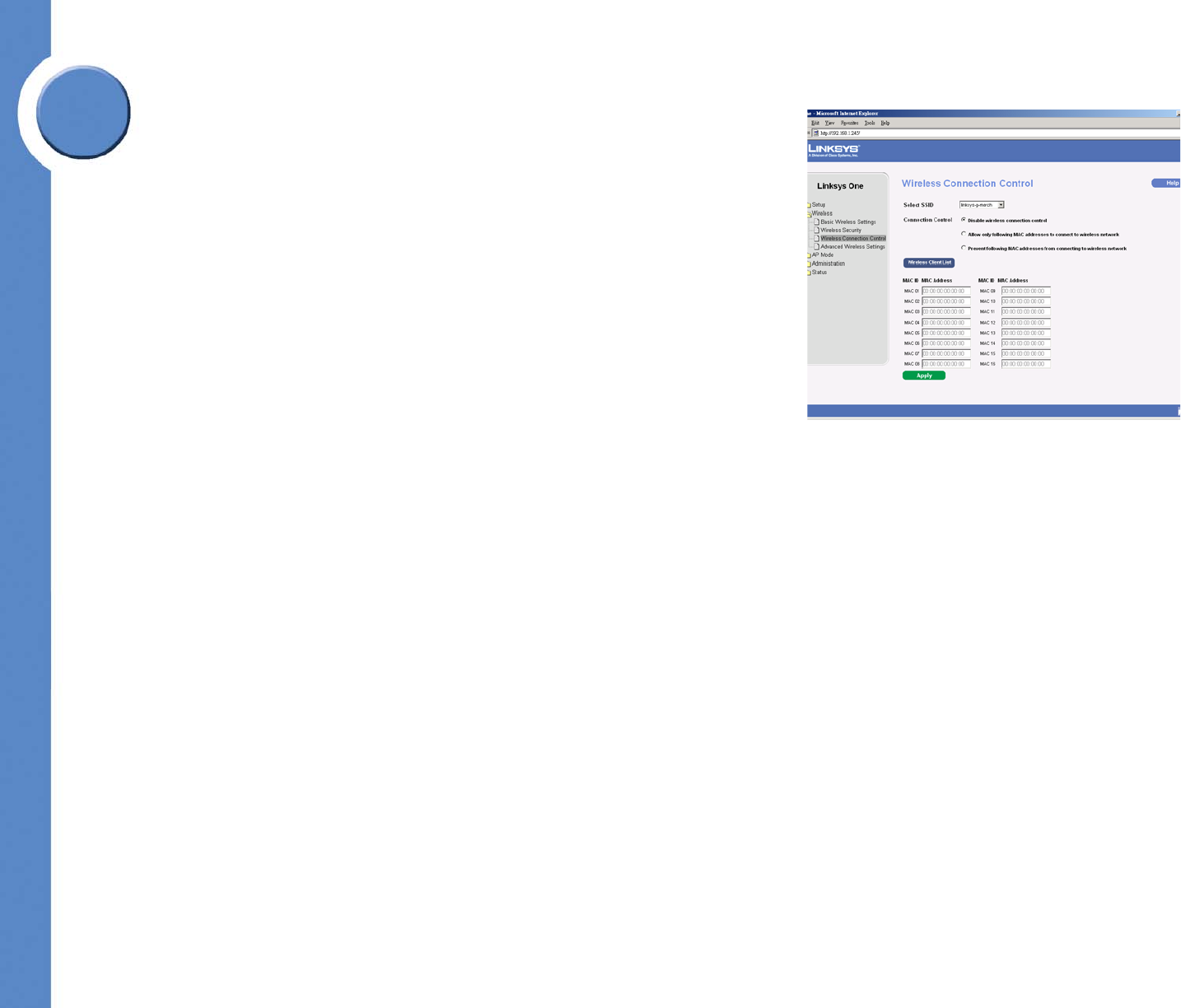
25
Chapter 6: Configuring the Wireless-G Access Point
The Wireless - Wireless Connection Control Tab
Linksys One Ready Communications Solution
Chapter
6The Wireless - Wireless Connection Control Tab
This screen allows you to configure the Connection Control List to either permit or block
specific wireless client devices connecting to (associating with) the Access Point.
Wireless Connection Control
Select SSID. Select the SSID of the wireless network that you want to use wireless connection
control on.
Enabled/Disabled. Enable or disable wireless connection control. The default is disabled.
Connection Control
Allow only following MAC addresses to connect to wireless network. When this option is
selected, only devices with a MAC address specified in the Connection Control List can connect
to the Access Point.
Prevent following MAC addresses from connecting to wireless network. When this option is
selected, devices with a MAC address specified in the Connection Control List will not be
allowed to connect to the Access Point.
Wireless Client List
Instead of manually entering the MAC addresses of each client, the Access Point provides a
convenient way to select a specific client device from the client association table. Click this
button and a window appears to let you select a MAC address from the table. The selected MAC
address will be entered into the Connection Control List.
Connection Control List
MAC 01-16. Enter the MAC addresses of the wireless client devices you want to control.
Change these settings as described here and click Save Settings to apply your changes, or click
Cancel Changes to cancel your changes. Help information is available on the right side of the
screen.

Chapter
6
26 Chapter 6: Configuring the Wireless-G Access Point
The Wireless - Advanced Wireless Settings Tab
Linksys One Ready Communications Solution
The Wireless - Advanced Wireless Settings Tab
This screen allows you to configure the advanced settings for the Access Point. Linksys
recommends to let your Access Point automatically adjust the parameters for maximum data
throughput.
Advanced Settings
CTS Protection Mode. CTS (Clear-To-Send) Protection Mode function boosts the Access
Point’s ability to catch all wireless transmissions, but will severely decrease performance. Keep
the default setting, Auto, so the Access Point can use this feature as needed, when the Wireless-
G products are not able to transmit to the Access Point in an environment with heavy 802.11b
traffic. Select Disabled if you want to permanently disable this feature.
BSSBasicRateSet. This setting is a series of rates that are advertised to other wireless devices as
defined in IEEE 802.11 specifications, so they know which data rates the Access Point can
support. One of the rates is picked from the list for transmitting control frames, broadcast/
multicast frames, or ACK frames. To support both 802.11b & 802.11g devices, use the Default
(Mixed mode) setting so that frames can be decoded by all devices. To support 802.11g devices
only, use the All (G-only mode) setting to achieve higher frame rates. For regular data frames,
the transmission rate is configured through the Tx Rate Limiting on the Wireless - VLAN & QoS
tab.
Power Output. The power output is set to its default setting which is 100%.
Beacon Interval. This value indicates the frequency interval of the beacon. A beacon is a packet
broadcast by the Access Point to keep the network synchronized. A beacon includes the wireless
networks service area, the Access Point address, the Broadcast destination addresses, a time
stamp, Delivery Traffic Indicator Maps, and the Traffic Indicator Message (TIM). The default is
100 ms.
DTIM Interval. This value indicates how often the Access Point sends out a Delivery Traffic
Indication Message (DTIM). Lower settings result in more efficient networking, while
preventing your PC from dropping into power-saving sleep mode. Higher settings allow your PC
to enter sleep mode, thus saving power, but interferes with wireless transmissions. The default is
1 ms.
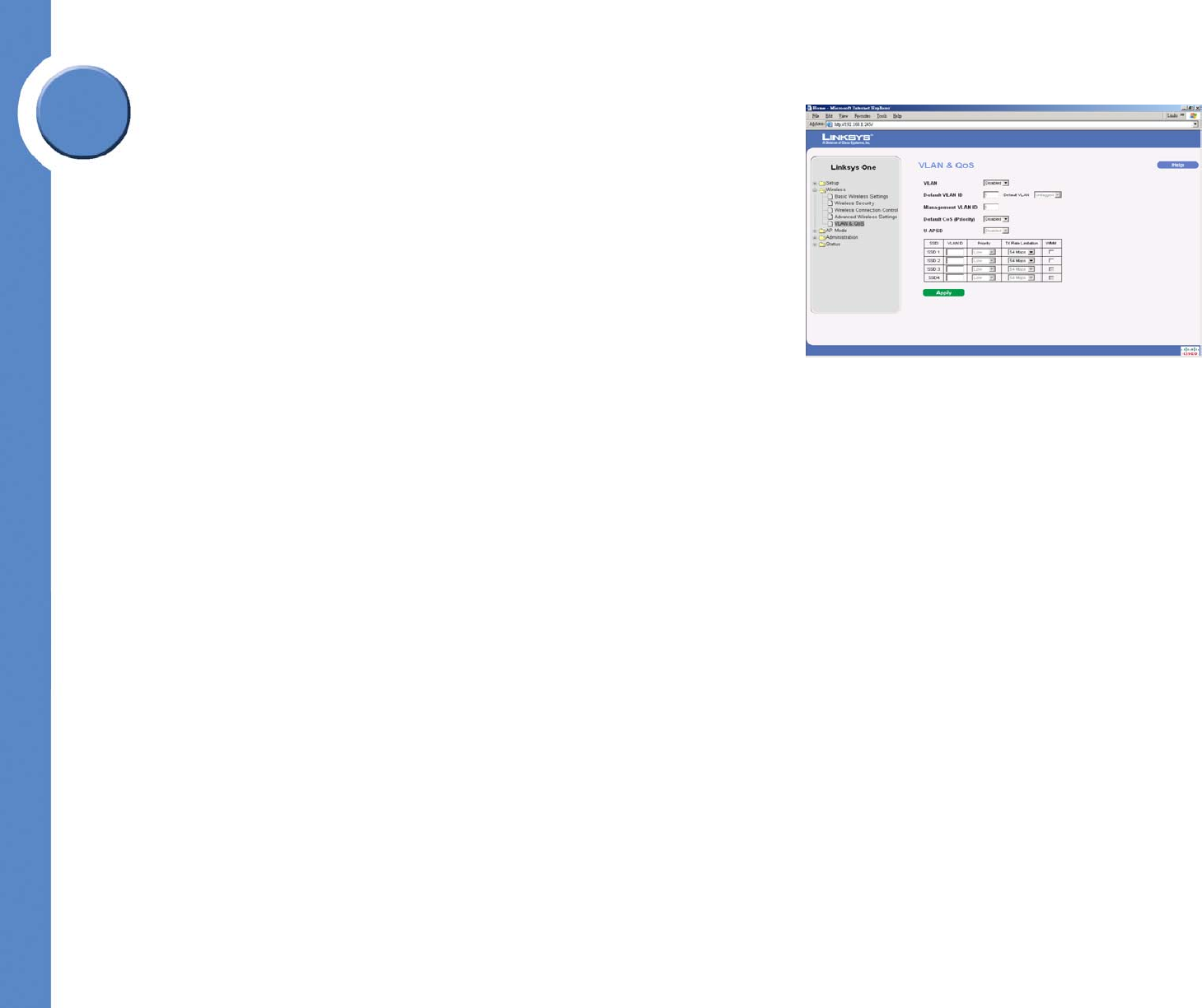
27
Chapter 6: Configuring the Wireless-G Access Point
The Wireless - VLAN & QoS Tab
Linksys One Ready Communications Solution
Chapter
6RTS Threshold. This setting determines how large a packet can be before the Access Point
coordinates transmission and reception to ensure efficient communication. This value should
remain at its default setting of 2347. If you encounter inconsistent data flow, only minor
modifications are recommended.
Fragmentation Threshold. This specifies the maximum size a data packet can be before
splitting and creating a new packet. It should remain at its default setting of 2346. A smaller
setting means smaller packets, which will create more packets for each transmission. If you
experience high packet error rates, you can decrease this value, but it will likely decrease overall
network performance. Only minor modifications of this value are recommended.
Change these settings as described here and click Save Settings to apply your changes, or click
Cancel Changes to cancel your changes. Help information is available on the right side of the
screen.
The Wireless - VLAN & QoS Tab
This screen allows you to configure the VLAN and QoS related settings for the Access Point.
VLAN
The following options are global VLAN settings for the Access Point.
VLAN. Select Enabled if you want to pass 802.1q VLAN tagged traffic between the wired LAN
and wireless LAN. Your Access Point will map the VLAN tag (wired side) to different SSIDs
(wireless side) according to your specified settings. Select Disabled and your Access Point will
drop all tagged traffic coming in from the wired LAN. The default is Disabled.
Default VLAN ID. Enter the VLAN ID number, the default VLAN is 1.
VLAN Tag. Untagged is the default and should be used if the VLAN ID does not carry a tag.
Otherwise, select the Tagged option.
AP Management VLAN. When the VLAN option is enabled, the value entered (VLAN ID) in
this field defines the VLAN that can connect to the Access Point's web-based utility. The default
setting is VLAN 1.
QoS
The following options are VLAN global settings for the Access Point.

Chapter
6
28 Chapter 6: Configuring the Wireless-G Access Point
The AP Mode Tab
Linksys One Ready Communications Solution
Default CoS (Priority). Select Enabled if you want to assign a default CoS value to each SSID.
This option is automatically enabled when the VLAN option is enabled. The default is Disabled.
U-APSD (Unscheduled Automatic Power Save Delivery). This option is only available when
WMM is enabled on any of the SSIDs. Select Enabled if you want client devices with U-APSD
capability to take advantage of the power save mode. The default is Disabled.
SSID Name. Displays the SSIDs defined under the Basic Wireless Settings tab. If an SSID has
been disabled, the options cannot be configured.
VLAN ID. Select a number between 1 and 4094 to identify the VLAN. Multiple SSIDs can
share the same VLAN value.
Priority. You can assign the default priority (802.1p COS bits) for packets coming in from each
wireless network by selecting a number from the drop-down menu. The higher the number, the
higher the priority will be. The default is 0.
Tx Rate Limiting. You can limit the maximum data rate used in your network to save
bandwidth and power consumption on client devices. The actual data rate is determined by the
Auto-Fallback mechanism between your Access Point and a client device. The default is 54
Mbps for Mixed or G-Only wireless mode, 11 Mbps for B-Only mode.
WMM. Wi-Fi Multimedia is a QoS feature defined by the WiFi Alliance before IEEE 802.11e
was finalized. Now it is part of IEEE 802.11e. When this is enabled, it provides four priority
queues for different types of traffic. It automatically maps the incoming packets to the
appropriate queues based on QoS settings (in the IP or layer 2 header). WMM provides the
capability to prioritize wireless traffic in your environment. The default is Disabled (unchecked).
The AP Mode Tab
On this screen you can change the Access Point’s mode of operation. In most cases, you can
keep the default setting - Access Point. You may wish to change the Access Point’s mode of
operation if you want to use the Access Point as a wireless repeater to extend the range of your
wireless network. You may also wish to change the Access Point’s mode of operation if you
want to use the Access Point as a wireless bridge; for example, you can use two Access Points in
Wireless Bridge mode to connect two wired networks that are in two different buildings.
AP Mode

29
Chapter 6: Configuring the Wireless-G Access Point
The Administration - Management Tab
Linksys One Ready Communications Solution
Chapter
6The Access Point offers three modes of operation: Access Point, Wireless Repeater, and
Wireless Bridge. For the Repeater and Bridge modes, make sure the SSID, channel, and security
settings are the same for the 0ther wireless access points/devices.
MAC Address
The MAC address of the Access Point is displayed here.
Access Point. The Mode is set to Access Point by default. This connects your wireless PCs to a
wired network. In most cases, no change is necessary.
Allow wireless signal to be repeated by a repeater. Select this option if you want to use
another wireless device to repeat the signal of this Access Point. You will need to enter the MAC
address(es) of the repeating device(s). Up to 3 repeaters can be used.
Wireless Repeater. When set to Wireless Repeater mode, the Wireless Repeater is able to talk to
up a remote access point within its range and retransmit its signal. Click Site Survey to select the
access point that will have its signal repeated by this Access Point or enter the MAC address of
the access point manually.
Wireless Bridge. This mode connects physically separated wired networks using multiple
access points. Wireless clients will not be able to connect to the access point in this mode. This
access point can operate in point-to-point and point-to-multipoint bridge mode. Like any
wireless bridge, the WAP2000 lets you wirelessly connect two or more Ethernet LANs together.
Enter the MAC address(es) of the access point(s) that will bridge to this access point.
The Administration - Management Tab
On this screen you can configure the password, Web Access, and SNMP settings.
Management
You should change the username/password that controls access to the Access Point’s Web-based
Utility to prevent unauthorized access.
Local AP Password
User Name. Modify the administrator user name. The default is admin.
AP Password. Modify the administrator password for the Access Point’s Web-based Utility. The
default is admin.

Chapter
6
30 Chapter 6: Configuring the Wireless-G Access Point
The Administration - Management Tab
Linksys One Ready Communications Solution
Re-enter to confirm. To confirm the new password, enter it again in this field.
Web Access
To increase the security on accessing the Web-based Utility, you can enable HTTPS. Once
enabled, users need to use https:// when accessing the Web-based Utility.
Web HTTPS Access. The default is Disabled.
Wireless Web Access. Allow or deny wireless clients to access Web based Utility. The default is
Disabled.
SNMP
SNMP is a popular network monitoring and management protocol. It provides network
administrators with the ability to monitor the status of the Access Point and receive notification
of any critical events as they occur on the Access Point.
To enable the SNMP support feature, select Enabled. Otherwise, select Disabled. The default is
Disabled.
This Access Point supports SNMP version 1, 2, and 3. Select SNMP V1 & V2 if you don’t need
the enhanced capability on V3 or your management software does not support V3. Otherwise,
select SNMP V3.
Identification
User Name. SNMPv3 only. Create a administrator account to access and manage the SNMP
MIB objects.
Authentication Password. SNMPv3 only. Enter the authentication password for administrator
account (minimum length 8).
Privacy Passphrase. SNMPv3 only. Enter the passphrase for data encryption on administrator’s
management traffic.
Get Community. Enter the password that allows read-only access to the Access Point’s SNMP
information. The default is public.
Set Community. Enter the password that allows read/write access to the Access Point’s SNMP
information. The default is private.
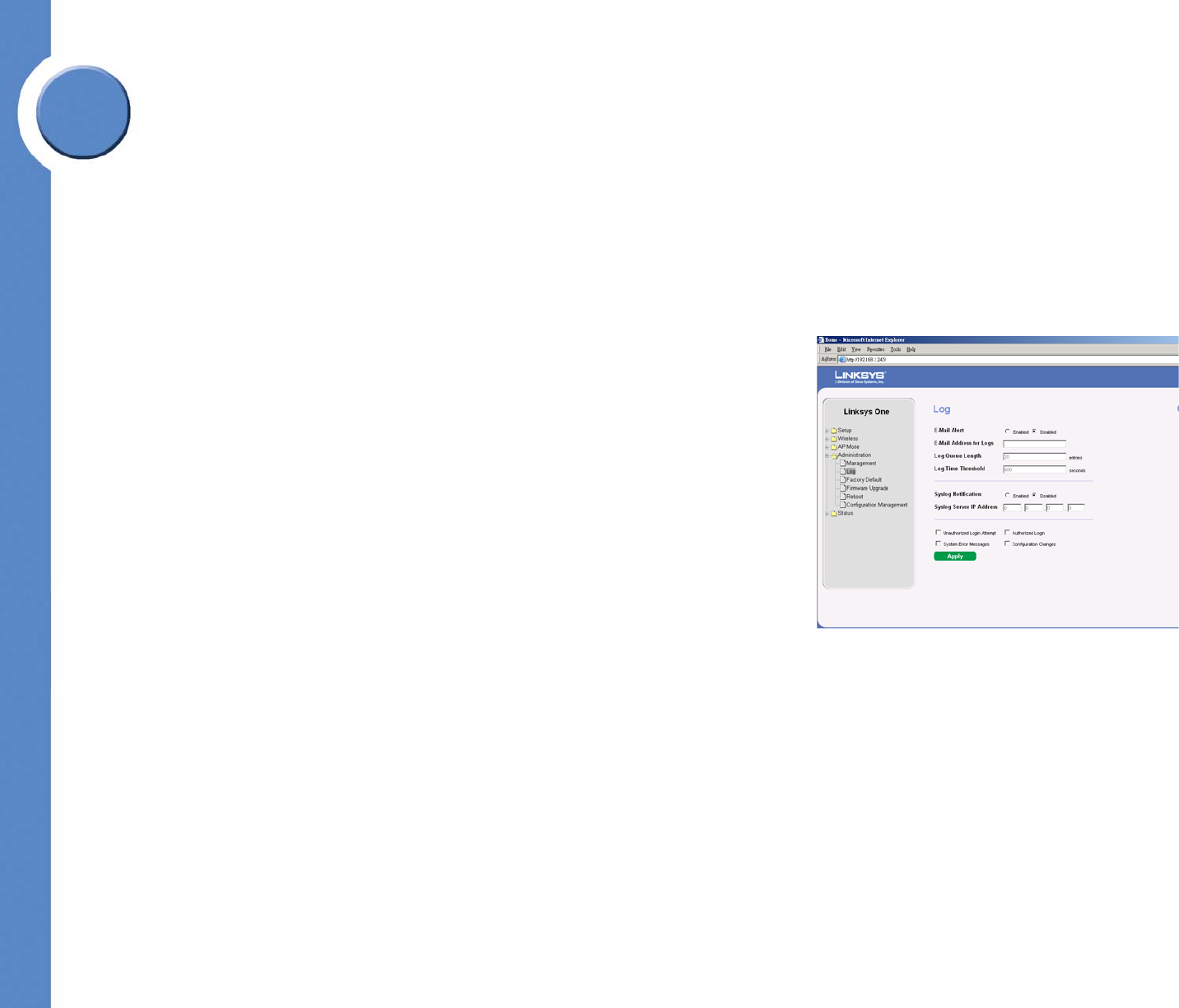
31
Chapter 6: Configuring the Wireless-G Access Point
The Administration - Log Tab
Linksys One Ready Communications Solution
Chapter
6SNMP Trap-Community. Enter the password required by the remote host computer that will
receive trap messages or notices sent by the Access Point.
SNMP Trusted Host. You can restrict access to the Access Point’s SNMP information by IP
address. Enter the IP address in the field provided. If this field is left blank, then access is
permitted from any IP address.
SNMP Trap-Destination. Enter the IP address of the remote host computer that will receive the
trap messages.
Change these settings as described here and click Save Settings to apply your changes, or click
Cancel Changes to cancel your changes. Help information is available on the right side of the
screen.
The Administration - Log Tab
On this screen you can configure the log settings and alerts of particular events.
Log
You can have logs that keep track of the Access Point’s activities.
Email Alert
E-Mail Alert. If you want the Access Point to send e-mail alerts in the event of certain attacks,
select Enabled. The default is Disabled.
E-Mail Address for Logs. Enter the e-mail address that will receive logs.
Log Queue Length. You can designate the length of the log that will be e-mailed to you. The
default is 20 entries.
Log Time Threshold. You can designate how often the log will be emailed to you. The default
is 600 seconds (10 minutes).
Syslog Notification
Syslog is a standard protocol used to capture information about network activity. The Access
Point supports this protocol and sends its activity logs to an external server. To enable Syslog,
select Enabled. The default is Disabled.

Chapter
6
32 Chapter 6: Configuring the Wireless-G Access Point
The Administration - Factory Default Tab
Linksys One Ready Communications Solution
Syslog Server IP Address. Enter the IP address of the Syslog server. In addition to the standard
event log, the Access Point can send a detailed log to an external Syslog server. The Access
Point’s Syslog captures all log activities and includes this information about all data
transmissions: every connection source and destination IP address, IP server, and number of
bytes transferred.
Log
Select the events that you want the Access Point to keep a log.
Unauthorized Login Attempt. If you want to receive alert logs about any unauthorized login
attempts, click the checkbox.
Authorized Login. If you want to log authorized logins, click the checkbox.
System Error Messages. If you want to log system error messages, click the checkbox.
Configuration Changes. If you want to log any configuration changes, click the checkbox.
Change these settings as described here and click Save Settings to apply your changes, or click
Cancel Changes to cancel your changes. Help information is available on the right side of the
screen.
The Administration - Factory Default Tab
On this screen you can restore the Access Point’s factory default settings.
Factory Default
Note any custom settings before you restore the factory defaults. Once the Access Point is reset,
you will have to re-enter all of your configuration settings.
Restore Factory Defaults. To restore the Access Point's factory default settings, click the Yes
radio button. Then, click Apply. Your Access Point will reboot and come back up with the
factory default settings in a few seconds.
Note: The Restore Factory Defaults will restore the device to its factory default which will erase
all of your saved changes. It also means that the Ethernet interface will be set to use DHCP.
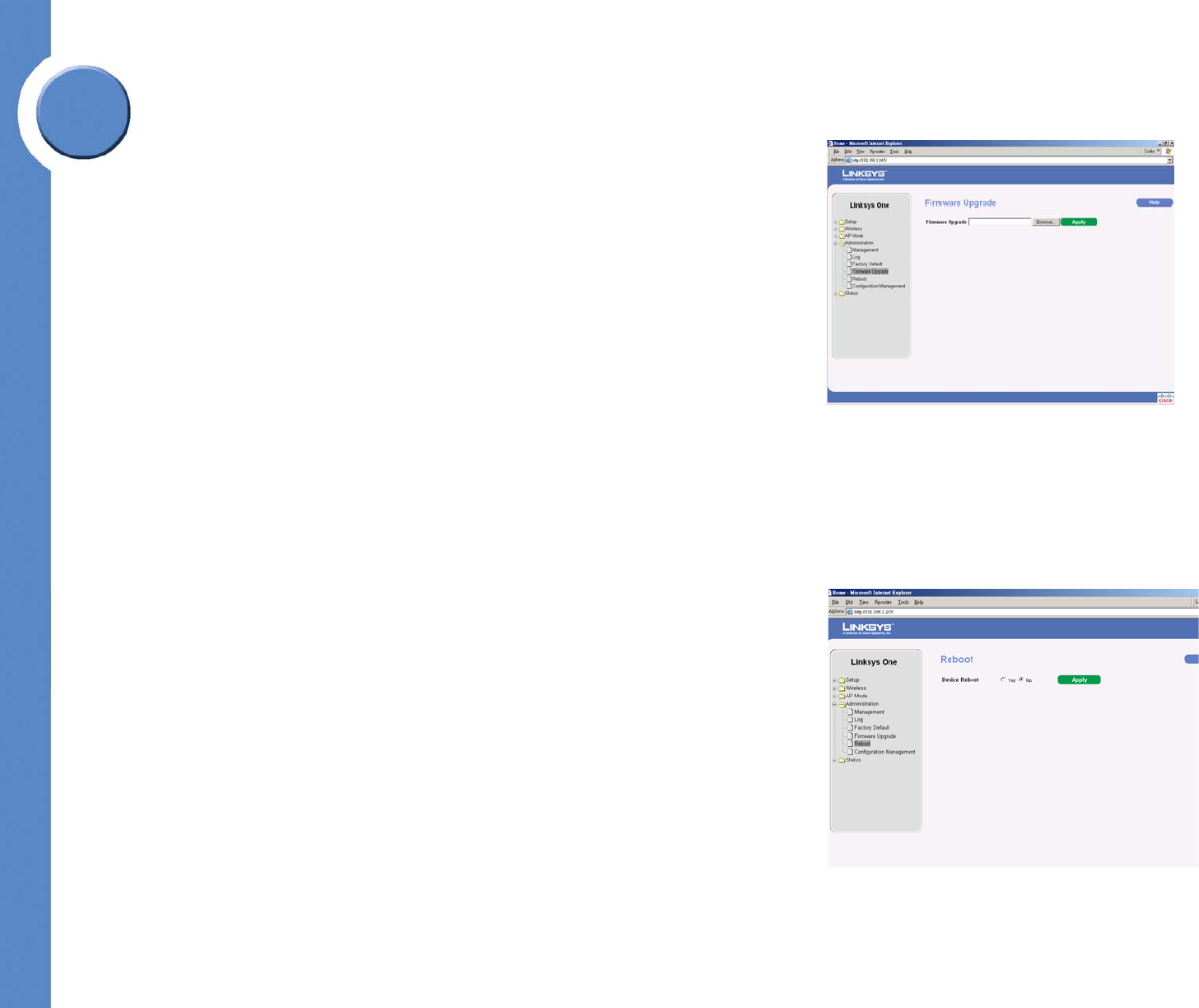
33
Chapter 6: Configuring the Wireless-G Access Point
The Administration - Firmware Upgrade Tab
Linksys One Ready Communications Solution
Chapter
6The Administration - Firmware Upgrade Tab
On this screen you can upgrade the Access Point’s firmware. Do not upgrade the firmware
unless you are experiencing problems with the Access Point or the new firmware has a feature
you want to use.
Firmware Upgrade
Before you upgrade the Access Point’s firmware, note all of your custom settings. After you
upgrade its firmware, you will have to re-enter all of your configuration settings. To upgrade the
Access Point’s firmware:
Download the firmware upgrade file from the Linksys website, www.linksys.com.
Extract the firmware upgrade file on your computer.
On the Firmware Upgrade screen, enter the location of the firmware upgrade file in the field
provided, or click the Browse button to find the file.
Click the Apply button, and follow the on-screen instructions.
Help information is available on the upper-right-hand side of the screen.
The Administration - Reboot Tab
On this screen you can reboot the Access Point.
Reboot
This feature is useful when you need to remotely reboot the Access Point.
Device Reboot. To reboot the Access Point, click the Ye s radio button.
Click Apply to apply your change and the Access Point will reboot itself, or cancel your change
by not clicking Apply. Help information is available on the upper-right-hand side of the screen.
The Administration - Config Management Tab
On this screen you can create a backup configuration file or save a configuration file to the
Access Point.
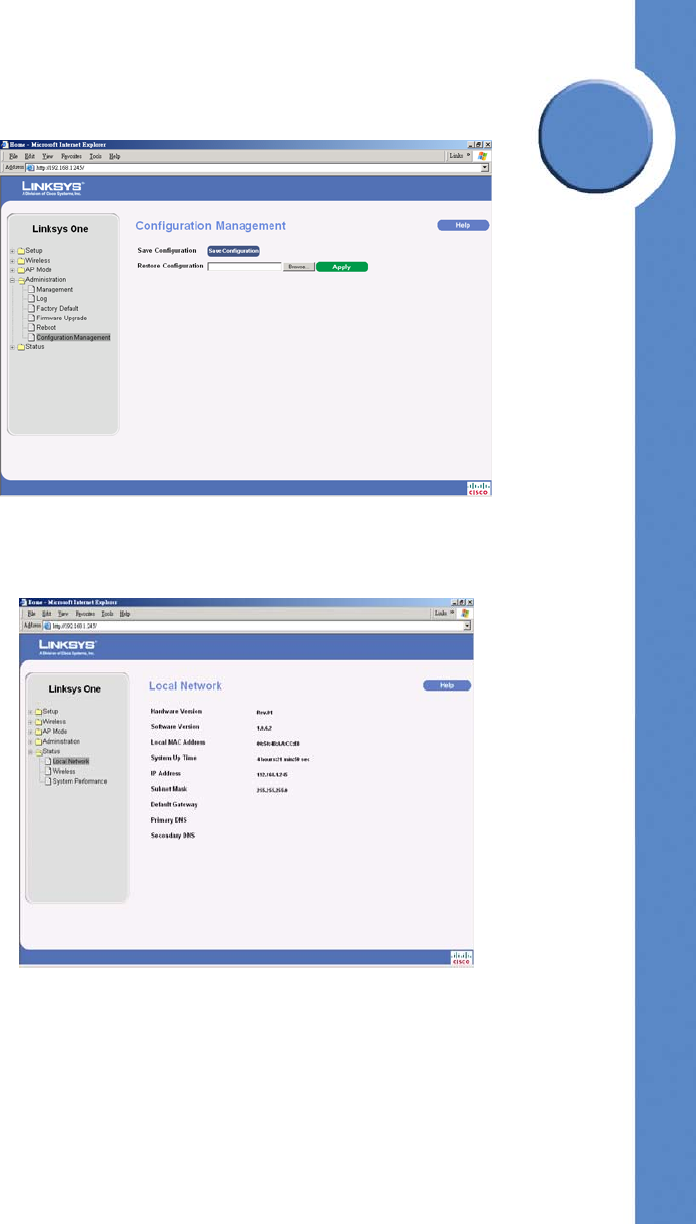
Chapter
6
34 Chapter 6: Configuring the Wireless-G Access Point
The Status - Local Network Tab
Linksys One Ready Communications Solution
Config Management
Use this screen to upload or download configuration files for the Access Point.
Save Configuration. To save a backup configuration file on a computer, click the Save
Configuration button and follow the on-screen instructions.
Restore Configuration. To upload a configuration file to the Access Point, enter the location of
the configuration file in the field provided, or click the Browse button to find the file. Then click
the Apply button.
Help information is available on the right side of the screen.
The Status - Local Network Tab
The Local Network screen displays the Access Point’s current status information for the local
network.
Information
Hardware Version. This is the version of the Access Point’s current hardware.
Software Version. This is the version of the Access Point’s current software.
Local MAC Address. The MAC address of the Access Point’s Local Area Network (LAN)
interface is displayed here.
System Up Time. This is the period of time the Access Point has been running.
Local Network
IP Address. This shows the Access Point’s IP Address, as it appears on your local network.
Subnet Mask. This shows the Access Point’s Subnet Mask.
To update the status information, click the Refresh button. Help information is available on the
right side of the screen.
Default Gateway. This shows the default gateway that has been set in the Setup Tab.
Primary DNS/Secondary DNS. This shows the primary/secondary DNS that has been set in the
Setup Tab.
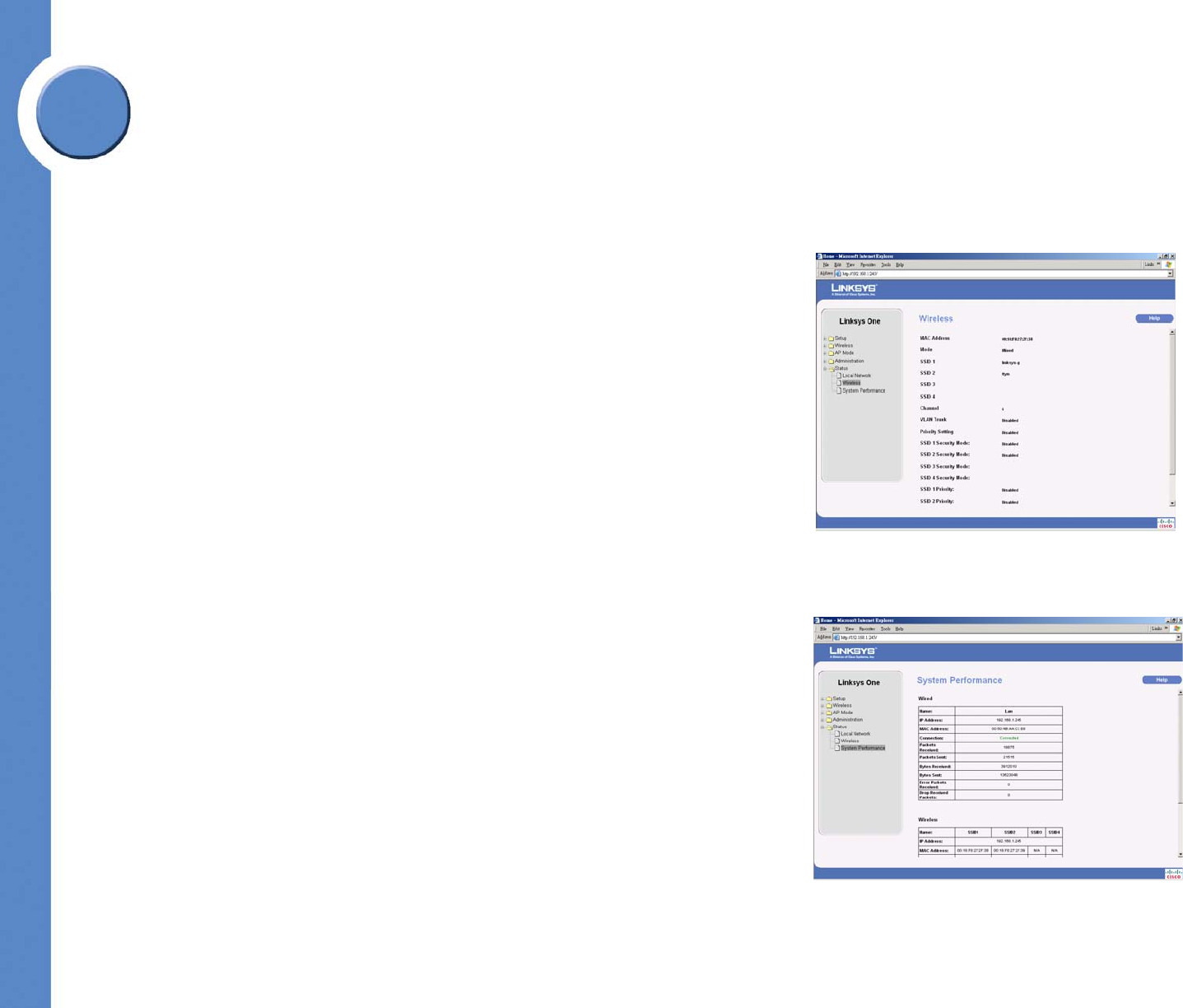
35
Chapter 6: Configuring the Wireless-G Access Point
The Status - Wireless Tab
Linksys One Ready Communications Solution
Chapter
6The Status - Wireless Tab
The Wireless screen displays the Access Point’s current status information for the wireless
network(s).
Wireless Network
MAC Address. The MAC Address of the Access Point’s wireless interface is displayed here.
Mode. The Access Point’s wireless network mode which could be B, G, mixed or disabled. is
displayed here.
SSID 1-4. The Access Point’s SSIDs that have been configured are displayed here.
Channel. The Access Point’s Channel setting for the SSID is shown here.
VLAN Trunk. The VLAN Trunk Status is displayed here.
Priority Setting. The priority setting status is displayed here.
To update the status information, click the Refresh button. Help information is available on the
right side of the screen.
The Status - System Performance Tab
The System Performance screen displays the Access Point’s status information for its current
settings and data transmissions.
System Performance
Wired
Name. This indicates that the statistics are for the wired network, the LAN.
IP Address. The Access Point’s local IP address is displayed here.
MAC Address. This shows the MAC Address of the Access Point’s wired interface.
Connection. This shows the status of the Access Point’s connection for the wired network.
Packets Received. This shows the number of packets received.

Chapter
6
36 Chapter 6: Configuring the Wireless-G Access Point
The Status - System Performance Tab
Linksys One Ready Communications Solution
Packets Sent. This shows the number of packets sent.
Bytes Received. This shows the number of bytes received.
Bytes Sent. This shows the number of bytes sent.
Error Packets Received. This shows the number of error packets received.
Drop Received Packets. This shows the number of packets being dropped after they were
received.
Wireless
Name. This indicates the wireless network/SSID to which the statistics refer.
IP Address. The Access Point’s local IP address is displayed here.
MAC Address. This shows the MAC Address of the Access Point’s wireless interface.
Connection. This shows the status of the Access Point’s wireless networks.
Packets Received. This shows the number of packets received for each wireless network.
Packets Sent. This shows the number of packets sent for each wireless network.
Bytes Received. This shows the number of bytes received for each wireless network.
Bytes Sent. This shows the number of bytes sent for each wireless network.
Error Packets Received. This shows the number of error packets received for each wireless
network.
Drop Received Packets. This shows the number of packets being dropped after they were
received.
To update the status information, click the Refresh button. Help information is available on the
upper-right-hand side of the screen.

37
Appendix A: Troubleshooting
Linksys One Ready Communications Solution
Appendix
ATroubleshooting
This appendix provides solutions to problems that may occur during the installation and
operation of the Wireless-G Access Point with Power Over Ethernet. Read the descriptions
below to help solve your problems. If you can't find an answer here, check the Linksys website
at www.linksys.com.
Frequently Asked Questions
Can the Access Point act as my DHCP Server?
No. The Access Point is nothing more than a wireless hub, and as such cannot be configured to
handle DHCP capabilities.
Can I run an application from a remote computer over the wireless network?
This will depend on whether or not the application is designed to be used over a network.
Consult the application’s documentation to determine if it supports operation over a network.
Can I play multiplayer games with other users of the wireless network?
Yes, as long as the game supports multiple players over a LAN (local area network). Refer to the
game’s documentation for more information.
What is the IEEE 802.11b standard?
It is one of the IEEE standards for wireless networks. The 802.11b standard allows wireless
networking hardware from different manufacturers to communicate, provided that the hardware
complies with the 802.11b standard. The 802.11b standard states a maximum data transfer rate
of 11Mbps and an operating frequency of 2.4GHz.
What is the IEEE 802.11g standard?
It is one of the IEEE standards for wireless networks. The 802.11g standard allows wireless
networking hardware from different manufacturers to communicate, provided that the hardware
complies with the 802.11g standard. The 802.11g standard states a maximum data transfer rate
of 54Mbps and an operating frequency of 2.4GHz.

Appendix
A
38 Appendix A: Troubleshooting
Linksys One Ready Communications Solution
What IEEE 802.11b features are supported?
The product supports the following IEEE 802.11 functions:
• CSMA/CA plus Acknowledge protocol
• Multi-Channel Roaming
• Automatic Rate Selection
• RTS/CTS feature
• Fragmentation
• Power Management
• What IEEE 802.11g features are supported?
• The product supports the following IEEE 802.11g functions:
• CSMA/CA plus Acknowledge protocol
• OFDM protocol
• Multi-Channel Roaming
• Automatic Rate Selection
• RTS/CTS feature
• Fragmentation
• Power Management
What is Ad-hoc?
An Ad-hoc wireless LAN is a group of computers, each with a WLAN adapter, connected as an
independent wireless LAN. An Ad-hoc wireless LAN is applicable at a departmental scale for a
branch or SOHO operation.

39
Appendix A: Troubleshooting
Linksys One Ready Communications Solution
Appendix
AWhat is Infrastructure?
An integrated wireless and wired LAN is called an Infrastructure configuration. Infrastructure is
applicable to enterprise scale for wireless access to a central database, or wireless application for
mobile workers.
What is roaming?
Roaming is the ability of a portable computer user to communicate continuously while moving
freely throughout an area greater than that covered by a single Access Point. Before using the
roaming function, the workstation must make sure that it is set to the same channel number as
the Access Point of the dedicated coverage area.
To achieve true seamless connectivity, the wireless LAN must incorporate a number of different
functions. Each node and Access Point, for example, must always acknowledge receipt of each
message. Each node must maintain contact with the wireless network even when not actually
transmitting data. Achieving these functions simultaneously requires a dynamic RF networking
technology that links Access Points and nodes. In such a system, the user’s end node undertakes
a search for the best possible access to the system. First, it evaluates such factors as signal
strength and quality, as well as the message load currently being carried by each Access Point
and the distance of each Access Point to the wired backbone. Based on that information, the
node next selects the right Access Point and registers its address. Communications between end
node and host computer can then be transmitted up and down the backbone.
As the user moves on, the end node’s RF transmitter regularly checks the system to determine
whether it is in touch with the original Access Point or whether it should seek a new one. When
a node no longer receives acknowledgment from its original Access Point, it undertakes a new
search. Upon finding a new Access Point, it then re-registers, and the communication process
continues.
What is the ISM band?
The FCC and their counterparts outside of the U.S. have set aside bandwidth for unlicensed use
in the ISM (Industrial, Scientific and Medical) band. Spectrum in the vicinity of 2.4 GHz, in
particular, is being made available worldwide. This presents a truly revolutionary opportunity to
place convenient high speed wireless capabilities in the hands of users around the globe.

Appendix
A
40 Appendix A: Troubleshooting
Linksys One Ready Communications Solution
What is Spread Spectrum?
Spread Spectrum technology is a wideband radio frequency technique developed by the military
for use in reliable, secure, mission-critical communications systems. It is designed to trade off
bandwidth efficiency for reliability, integrity, and security. In other words, more bandwidth is
consumed than in the case of narrowband transmission, but the trade-off produces a signal that
is, in effect, louder and thus easier to detect, provided that the receiver knows the parameters of
the spread-spectrum signal being broadcast. If a receiver is not tuned to the right frequency, a
spread-spectrum signal looks like background noise. There are two main alternatives, Direct
Sequence Spread Spectrum (DSSS) and Frequency Hopping Spread Spectrum (FHSS).
What is DSSS? What is FHSS? And what are their differences?
Frequency Hopping Spread Spectrum (FHSS) uses a narrowband carrier that changes frequency
in a pattern that is known to both transmitter and receiver. Properly synchronized, the net effect
is to maintain a single logical channel. To an unintended receiver, FHSS appears to be short-
duration impulse noise. Direct Sequence Spread Spectrum (DSSS) generates a redundant bit
pattern for each bit to be transmitted. This bit pattern is called a chip (or chipping code). The
longer the chip, the greater the probability that the original data can be recovered. Even if one or
more bits in the chip are damaged during transmission, statistical techniques embedded in the
radio can recover the original data without the need for retransmission. To an unintended
receiver, DSSS appears as low power wideband noise and is rejected (ignored) by most
narrowband receivers.
Would the information be intercepted while transmitting on air?
WLAN features two-fold protection in security. On the hardware side, as with Direct Sequence
Spread Spectrum technology, it has the inherent security feature of scrambling. On the software
side, the WLAN series offers a variety of wireless security methods to enhance security and
access control. Users can set it up depending upon their needs.
Can Linksys wireless products support file and printer sharing?
Linksys wireless products perform the same function as LAN products. Therefore, Linksys
wireless products can work with NetWare, Windows NT/2000, or other LAN operating systems
to support printer or file sharing.
What is WEP?
WEP is Wired Equivalent Privacy, a data privacy mechanism based on a 40-bit shared-key
algorithm, as described in the IEEE 802.11 standard.

41
Appendix A: Troubleshooting
Linksys One Ready Communications Solution
Appendix
AWhat is a MAC Address?
The Media Access Control (MAC) address is a unique number assigned by the manufacturer to
any Ethernet networking device, such as a network adapter, that allows the network to identify it
at the hardware level. For all practical purposes, this number is usually permanent. Unlike IP
addresses, which can change every time a computer logs on to the network, the MAC address of
a device stays the same, making it a valuable identifier for the network.
How do I avoid interference?
Using multiple Access Points on the same channel and in close proximity to one another will
generate interference. When employing multiple Access Points, make sure to operate each one
on a different channel (frequency).
How do I reset the Access Point?
Press the Reset button on the back of the Access Point for about ten seconds. This will reset the
unit to its default settings.
How do I resolve issues with signal loss?
There is no way to know the exact range of your wireless network without testing. Every
obstacle placed between an Access Point and wireless PC will create signal loss. Leaded glass,
metal, concrete floors, water, and walls will inhibit the signal and reduce range. Start with your
Access Point and your wireless PC in the same room and move it away in small increments to
determine the maximum range in your environment.
You may also try using different channels, as this may eliminate interference affecting only one
channel.

Appendix
A
42 Appendix A: Troubleshooting
Linksys One Ready Communications Solution
Does the Access Point function as a firewall?
No. The Access Point is only a bridge from wired Ethernet to wireless clients.
I have excellent signal strength, but I cannot see my network.
Wireless security, such as WEP or WPA, is probably enabled on the Access Point, but not on
your wireless adapter (or vice versa). Verify that the same wireless security settings are being
used on all devices in your wireless network.
What is the maximum number of users the Access Point can handle?
No more than 63, but this depends on the volume of data and may be fewer if many users create
a large amount of network traffic.

43
Appendix B: Wireless Security
Linksys One Ready Communications Solution
Appendix
BWireless Security
Linksys wants to make wireless networking as safe and easy for you as possible. The current
generation of Linksys products provide several network security features, but they require
specific action on your part for implementation. So, keep the following in mind whenever you
are setting up or using your wireless network.
Security Precautions
The following is a complete list of security precautions to take (as shown in this User Guide) (at
least steps 1 through 5 should be followed):
1. Change the default SSID.
2. Disable SSID Broadcast.
3. Change the default password for the Administrator account.
4. Enable MAC Address Filtering.
5. Change the SSID periodically.
6. Use the highest encryption algorithm possible. Use WPA if it is available. Please note that
this may reduce your network performance.
7. Change the WEP encryption keys periodically.
8. To ensure network security, steps one through five should be followed, at least.
Security Threats Facing Wireless Networks
Wireless networks are easy to find. Hackers know that in order to join a wireless network,
wireless networking products first listen for “beacon messages”. These messages can be easily
decrypted and contain much of the network’s information, such as the network’s SSID (Service
Set Identifier). Here are the steps you can take:
Change the administrator’s password regularly. With every wireless networking device you
use, keep in mind that network settings (SSID, WEP keys, etc.) are stored in its firmware. Your
NOTE: Some of these security features are available only
through the network router or access point. Refer to the
router or access point’s documentation for more
information.

Appendix
B
44 Appendix B: Wireless Security
Linksys One Ready Communications Solution
network administrator is the only person who can change network settings. If a hacker gets a
hold of the administrator’s password, he, too, can change those settings. So, make it harder for a
hacker to get that information. Change the administrator’s password regularly.
SSID. There are several things to keep in mind about the SSID:
1. Disable Broadcast
2. Make it unique
3. Change it often
Most wireless networking devices will give you the option of broadcasting the SSID. While this
option may be more convenient, it allows anyone to log into your wireless network. This
includes hackers. So, don’t broadcast the SSID.
Wireless networking products come with a default SSID set by the factory. (The Linksys default
SSID is “linksys”.) Hackers know these defaults and can check these against your network.
Change your SSID to something unique and not something related to your company or the
networking products you use.
Change your SSID regularly so that any hackers who have gained access to your wireless
network will have to start from the beginning in trying to break in.
MAC Addresses. Enable MAC Address filtering. MAC Address filtering will allow you to
provide access to only those wireless nodes with certain MAC Addresses. This makes it harder
for a hacker to access your network with a random MAC Address.
WEP Encryption. Wired Equivalent Privacy (WEP) is often looked upon as a cure-all for
wireless security concerns. This is overstating WEP’s ability. Again, this can only provide
enough security to make a hacker’s job more difficult.

45
Appendix B: Wireless Security
Linksys One Ready Communications Solution
Appendix
BThere are several ways that WEP can be maximized:
1. Use the highest level of encryption possible
2. Change your WEP key regularly
WPA. Wi-Fi Protected Access (WPA) is the replacement standard for WEP in Wi-Fi security.
Two modes are available: Personal, and Enterprise. Both give you a choice of two encryption
methods: TKIP (Temporal Key Integrity Protocol), which utilizes a stronger encryption method
and incorporates Message Integrity Code (MIC) to provide protection against hackers, and AES
(Advanced Encryption System), which utilizes a symmetric 128-Bit block data encryption.
Enterprise utilizes a RADIUS server for authentication and the use of dynamic TKIP, AES, or
WEP.
WPA Personal. If you do not have a RADIUS server, select the type of algorithm, TKIP or
AES, enter a password in the Pre-Shared key field of 8-63 characters, and enter a Group Key
Renewal period time between 0 and 99,999 seconds, which instructs the AP or other device how
often it should change the encryption keys.
WPA Enterprise. WPA used in coordination with a RADIUS server. (This should only be used
when a RADIUS server is connected to the AP or other device.) First, select the type of WPA
algorithm, TKIP or AES. Enter the RADIUS server’s IP Address and port number, along with a
key shared between the device and the server. Last, enter a Group Key Renewal period, which
instructs the device how often it should change the encryption keys.
WPA2. Wi-Fi Protected Access 2 (WPA2) is the latest security standard in Wi-Fi security. Two
modes are available: Personal and Enterprise. WPA2 always uses AES (Advanced Encryption
System) for stronger data encryption.
WPA2 Personal. If you do not have a RADIUS server, enter a password in the Pre-Shared key
field of 8-63 characters, and enter a Group Key Renewal period time between 0 and 99,999
seconds, which instructs the AP or other device how often it should change the encryption keys.
IMPORTANT: Always remember that
each device in your wireless network
MUST use the same encryption method
and encryption key or your wireless
network will not function properly.

Appendix
B
46 Appendix B: Wireless Security
Linksys One Ready Communications Solution
WPA2 Enterprise. WPA2 used in coordination with a RADIUS server. (This should only be
used when a RADIUS server is connected to the AP or other device.) First, enter the RADIUS
server’s IP Address and port number, along with a key shared between the device and the server.
Then, enter a Group Key Renewal period, which instructs the device how often it should change
the encryption keys.
WPA2 Mixed. WPA2 Mixed modes provide users an upgrade path from WPA to WPA2. You can
have client devices running both WPA and WPA2 and the Access Point will automatically select
the security method used by the client.
Implementing encryption may have a negative impact on your network’s performance, but if you
are transmitting sensitive data over your network, encryption should be used.
These security recommendations should help keep your mind at ease while you are enjoying the
most flexible and convenient technology Linksys has to offer.

47
Appendix C: Upgrading Firmware
Linksys One Ready Communications Solution
Appendix
CUpgrading Firmware
The Access Point's firmware is upgraded through the Web-based Utility’s Administration -
Firmware Upgrade tab. Follow these instructions:
1. Download the firmware upgrade file from the Linksys website, www.linksys.com.
2. Extract the firmware upgrade file on your computer.
3. Open the Access Point’s Web-based Utility.
4. Click the Administration tab.
5. Click the Upgrade Firmware tab.
6. On the Firmware Upgrade screen, enter the location of the firmware upgrade file in the field
provided, or click the Browse button to find the file.
7. Click the Upgrade button, and follow the on-screen instructions.

Appendix
C
48 Appendix C: Upgrading Firmware
Linksys One Ready Communications Solution

49
Appendix D: Windows Help
Linksys One Ready Communications Solution
Appendix
DWindows Help
Almost all wireless products require Microsoft Windows. Windows is the most used operating
system in the world and comes with many features that help make networking easier. These
features can be accessed through Windows Help and are described in this appendix.
TCP/IP
Before a computer can communicate with the Access Point, TCP/IP must be enabled. TCP/IP is
a set of instructions, or protocol, all PCs follow to communicate over a network. This is true for
wireless networks as well. Your PCs will not be able to utilize wireless networking without
having TCP/IP enabled. Windows Help provides complete instructions on enabling TCP/IP.
Shared Resources
If you wish to share printers, folder, or files over your network, Windows Help provides
complete instructions on utilizing shared resources.
Network Neighborhood/My Network Places
Other PCs on your network will appear under Network Neighborhood or My Network Places
(depending upon the version of Windows you're running). Windows Help provides complete
instructions on adding PCs to your network.

Appendix
D
50 Appendix D: Windows Help
Linksys One Ready Communications Solution

51
Appendix E: Glossary
Linksys One Ready Communications Solution
Appendix
EGlossary
This glossary contains some basic networking terms you may come across when using this
product. For more advanced terms, see the complete Linksys glossary at http://
www.linksys.com/glossary.
Access Point - A device that allows wireless-equipped computers and other devices to
communicate with a wired network. Also used to expand the range of a wireless network.
Ad-hoc - A group of wireless devices communicating directly with each other (peer-to-peer)
without the use of an access point.
AES (Advanced Encryption Standard) - A security method that uses symmetric 128-bit block
data encryption.
Bandwidth - The transmission capacity of a given device or network.
Bit - A binary digit.
Boot - To start a device and cause it to start executing instructions.
Broadband - An always-on, fast Internet connection.
Browser - An application program that provides a way to look at and interact with all the
information on the World Wide Web.
Byte - A unit of data that is usually eight bits long
Cable Modem - A device that connects a computer to the cable television network, which in
turn connects to the Internet.
Daisy Chain - A method used to connect devices in a series, one after the other.
DDNS (Dynamic Domain Name System) - Allows the hosting of a website, FTP server, or e-
mail server with a fixed domain name (e.g., www.xyz.com) and a dynamic IP address.
Default Gateway - A device that forwards Internet traffic from your local area network.

Appendix
E
52 Appendix E: Glossary
Linksys One Ready Communications Solution
DHCP (Dynamic Host Configuration Protocol) - A networking protocol that allows
administrators to assign temporary IP addresses to network computers by “leasing” an IP address
to a user for a limited amount of time, instead of assigning permanent IP addresses.
DMZ (Demilitarized Zone) - Removes the Router's firewall protection from one PC, allowing it
to be “seen” from the Internet.
DNS (Domain Name Server) - The IP address of your ISP's server, which translates the names of
websites into IP addresses.
Domain - A specific name for a network of computers.
Download - To receive a file transmitted over a network.
DSL (Digital Subscriber Line) - An always-on broadband connection over traditional phone
lines.
Dynamic IP Address - A temporary IP address assigned by a DHCP server.
EAP (Extensible Authentication Protocol) - A general authentication protocol used to control
network access. Many specific authentication methods work within this framework.
Encryption - Encoding data transmitted in a network.
Ethernet - IEEE standard network protocol that specifies how data is placed on and retrieved
from a common transmission medium.
Firewall - A set of related programs located at a network gateway server that protects the
resources of a network from users from other networks.
Firmware - The programming code that runs a networking device.
FTP (File Transfer Protocol) - A protocol used to transfer files over a TCP/IP network.
Full Duplex - The ability of a networking device to receive and transmit data simultaneously.
Gateway - A device that interconnects networks with different, incompatible communications
protocols.
Half Duplex - Data transmission that can occur in two directions over a single line, but only one
direction at a time.

53
Appendix E: Glossary
Linksys One Ready Communications Solution
Appendix
EHTTP (HyperText Transport Protocol) - The communications protocol used to connect to
servers on the World Wide Web.
Infrastructure - A wireless network that is bridged to a wired network via an access point.
IP (Internet Protocol) - A protocol used to send data over a network.
IP Address - The address used to identify a computer or device on a network.
IPCONFIG - A Windows 2000 and XP utility that displays the IP address for a particular
networking device.
IPSec (Internet Protocol Security) - A VPN protocol used to implement secure exchange of
packets at the IP layer.
ISP (Internet Service Provider) - A company that provides access to the Internet.
LAN - The computers and networking products that make up your local network.
MAC (Media Access Control) Address - The unique address that a manufacturer assigns to
each networking device.
Mbps (MegaBits Per Second) - One million bits per second; a unit of measurement for data
transmission.
NAT (Network Address Translation) - NAT technology translates IP addresses of a local area
network to a different IP address for the Internet.
Network - A series of computers or devices connected for the purpose of data sharing, storage,
and/or transmission between users.
Packet - A unit of data sent over a network.
Passphrase - Used much like a password, a passphrase simplifies the WEP encryption process
by automatically generating the WEP encryption keys for Linksys products.
Ping (Packet INternet Groper) - An Internet utility used to determine whether a particular IP
address is online.
POP3 (Post Office Protocol 3) - A standard mail server commonly used on the Internet.

Appendix
E
54 Appendix E: Glossary
Linksys One Ready Communications Solution
Port - The connection point on a computer or networking device used for plugging in cables or
adapters.
Power over Ethernet (PoE) - A technology enabling an Ethernet network cable to deliver both
data and power.
PPPoE (Point to Point Protocol over Ethernet) - A type of broadband connection that provides
authentication (username and password) in addition to data transport.
PPTP (Point-to-Point Tunneling Protocol) - A VPN protocol that allows the Point to Point
Protocol (PPP) to be tunneled through an IP network. This protocol is also used as a type of
broadband connection in Europe.
RADIUS (Remote Authentication Dial-In User Service) - A protocol that uses an authentication
server to control network access.
RJ-45 (Registered Jack-45) - An Ethernet connector that holds up to eight wires.
Roaming - The ability to take a wireless device from one access point's range to another without
losing the connection.
Router - A networking device that connects multiple networks together.
Server - Any computer whose function in a network is to provide user access to files, printing,
communications, and other services.
SMTP (Simple Mail Transfer Protocol) - The standard e-mail protocol on the Internet.
SNMP (Simple Network Management Protocol) - A widely used network monitoring and
control protocol.
SPI (Stateful Packet Inspection) Firewall - A technology that inspects incoming packets of
information before allowing them to enter the network.
SSID (Service Set IDentifier) - Your wireless network's name.
Static IP Address - A fixed address assigned to a computer or device that is connected to a
network.
Static Routing - Forwarding data in a network via a fixed path.
Subnet Mask - An address code that determines the size of the network.

55
Appendix E: Glossary
Linksys One Ready Communications Solution
Appendix
ESwitch - 1. A data switch that connects computing devices to host computers, allowing a large
number of devices to share a limited number of ports. 2. A device for making, breaking, or
changing the connections in an electrical circuit.
TCP (Transmission Control Protocol) - A network protocol for transmitting data that requires
acknowledgement from the recipient of data sent.
TCP/IP (Transmission Control Protocol/Internet Protocol) - A set of instructions PCs use to
communicate over a network.
Telnet - A user command and TCP/IP protocol used for accessing remote PCs.
TFTP (Trivial File Transfer Protocol) - A version of the TCP/IP FTP protocol that has no
directory or password capability.
Throughput - The amount of data moved successfully from one node to another in a given time
period.
TKIP (Temporal Key Integrity Protocol) - a wireless encryption protocol that provides dynamic
encryption keys for each packet transmitted.
Topology - The physical layout of a network.
TX Rate - Transmission Rate.
Upgrade - To replace existing software or firmware with a newer version.
Upload - To transmit a file over a network.
URL (Uniform Resource Locator) - The address of a file located on the Internet.
VPN (Virtual Private Network) - A security measure to protect data as it leaves one network and
goes to another over the Internet.
WAN (Wide Area Network)- The Internet.
WEP (Wired Equivalent Privacy) - A method of encrypting network data transmitted on a
wireless network for greater security.
WLAN (Wireless Local Area Network) - A group of computers and associated devices that
communicate with each other wirelessly.

Appendix
E
56 Appendix E: Glossary
Linksys One Ready Communications Solution
WPA (Wi-Fi Protected Access) - a wireless security protocol using TKIP (Temporal Key
Integrity Protocol) encryption, which can be used in conjunction with a RADIUS server.

57
Appendix E: Glossary
Linksys One Ready Communications Solution
Appendix
E

Appendix
F
58 Appendix F: Regulatory Information
Linksys One Ready Communications Solution
Regulatory Information
Federal Communication Commission Interference Statement
This equipment has been tested and found to comply with the limits for a Class B digital device,
pursuant to Part 15 of the FCC Rules. These limits are designed to provide reasonable protection
against harmful interference in a residential installation. This equipment generates, uses and can
radiate radio frequency energy and, if not installed and used in accordance with the instructions,
may cause harmful interference to radio communications. However, there is no guarantee that
interference will not occur in a particular installation. If this equipment does cause harmful
interference to radio or television reception, which can be determined by turning the equipment
off and on, the user is encouraged to try to correct the interference by one of the following
measures:
- Reorient or relocate the receiving antenna.
- Increase the separation between the equipment and receiver.
- Connect the equipment into an outlet on a circuit different from that
to which the receiver is connected.
- Consult the dealer or an experienced radio/TV technician for help.
FCC Caution: Any changes or modifications not expressly approved by the party responsible for
compliance could void the user's authority to operate this equipment.
This device complies with Part 15 of the FCC Rules. Operation is subject to the following two
conditions: (1) This device may not cause harmful interference, and (2) this device must accept
any interference received, including interference that may cause undesired operation.
FCC Radiation Exposure Statement:
This equipment complies with FCC radiation exposure limits set forth for an uncontrolled
environment. This equipment should be installed and operated with minimum distance 20cm
between the radiator & your body.

59
Appendix F: Regulatory Information
Linksys One Ready Communications Solution
Appendix
FThis transmitter must not be co-located or operating in conjunction with any other antenna or
transmitter.
The availability of some specific channels and/or operational frequency bands are country
dependent and are firmware programmed at the factory to match the intended destination. The
firmware setting is not accessible by the end user.
Industry Canada statement:
This Class B digital apparatus complies with Canadian ICES-003.
Cet appareil numérique de la classe B est conforme à la norme NMB-003 du Canada.
This device complies with RSS-210 of the Industry Canada Rules. Operation is subject to the
following two conditions: (1) This device may not cause harmful interference, and (2) this
device must accept any interference received, including interference that may cause undesired
operation.
Règlement d’Industry Canada
Les conditions de fonctionnement sont sujettes à deux conditions:
• Ce périphérique ne doit pas causer d’interférence et.
• Ce périphérique doit accepter toute interférence, y compris les interférences pouvant
perturber le bon fonctionnement de ce périphérique.
IMPORTANT NOTE:
Radiation Exposure Statement:
This equipment complies with IC radiation exposure limits set forth for an uncontrolled
environment. This equipment should be installed and operated with minimum distance 20cm
between the radiator & your body.
This device has been designed to operate with an antenna having a maximum gain of 3 dBi.
Antenna having a higher gain is strictly prohibited per regulations of Industry Canada. The
required antenna impedance is 50 ohms.

60 Appendix G: Linksys Contact Information
Linksys One Ready Communications Solution
G
Linksys Contact Information
Need to contact Linksys?
Visit us online for information on the latest products and updates to your existing products at:
http://www.linksys.com/international
If you experience problems with any Linksys product, you can e-mail us at:
In Europe E-mail Address
Austria support.at@linksys.com
Belgium support.be@linksys.com
Czech Republic support.cz@linksys.com
Denmark support.dk@linksys.com
Finland support.fi@linksys.com
France support.fr@linksys.com
Germany support.de@linksys.com
Greece support.gr@linksys.com (English only)
Hungary support.hu@linksys.com
Ireland support.ie@linksys.com
Italy support.it@linksys.com
Netherlands support.nl@linksys.com
Norway support.no@linksys.com
Poland support.pl@linksys.com
Portugal support.pt@linksys.com

61
Appendix G: Linksys Contact Information
Linksys One Ready Communications Solution
Appendix
GRussia support.ru@linksys.com
Spain support.es@linksys.com
Sweden support.se@linksys.com
Switzerland support.ch@linksys.com
United Kingdom support.uk@linksys.com
Outside of Europe E-mail Address
Asia Pacific asiasupport@linksys.com (English only)
Latin America support.portuguese@linksys.com or
support.spanish@linksys.com
Middle East & Africa support.mea@linksys.com (English only)
South Africa support.ze@linksys.com (English only)
UAE support.ae@linksys.com (English only)
U.S. and Canada support@linksys.com
In Europe E-mail Address

©2007 Cisco Systems, Inc. All rights reserved. Linksys is a registered trademark and the Linksys One logo is a trademark of Cisco Systems, Inc.
Software Release Number 1.8.0